Facilitate the Empowerment of Older People - CHCAGE001 Learner Workbook
VerifiedAdded on 2023/06/18
|22
|5961
|416
AI Summary
The CHCAGE001 Learner Workbook provides activities and knowledge assessments to facilitate the empowerment of older people. It covers legal and ethical considerations, identifying services, and assisting in complaints mechanisms. The workbook includes examples and checklists for each activity. The subject is CHCAGE001 and is relevant for those studying aged care.
Contribute Materials
Your contribution can guide someone’s learning journey. Share your
documents today.

CHCAGE001 Learner Workbook V 2.1 Page 1 of 22
CHCAGE001
Facilitate the empowerment of
older people
Learner Workbook
CHCAGE001
Facilitate the empowerment of
older people
Learner Workbook
Secure Best Marks with AI Grader
Need help grading? Try our AI Grader for instant feedback on your assignments.
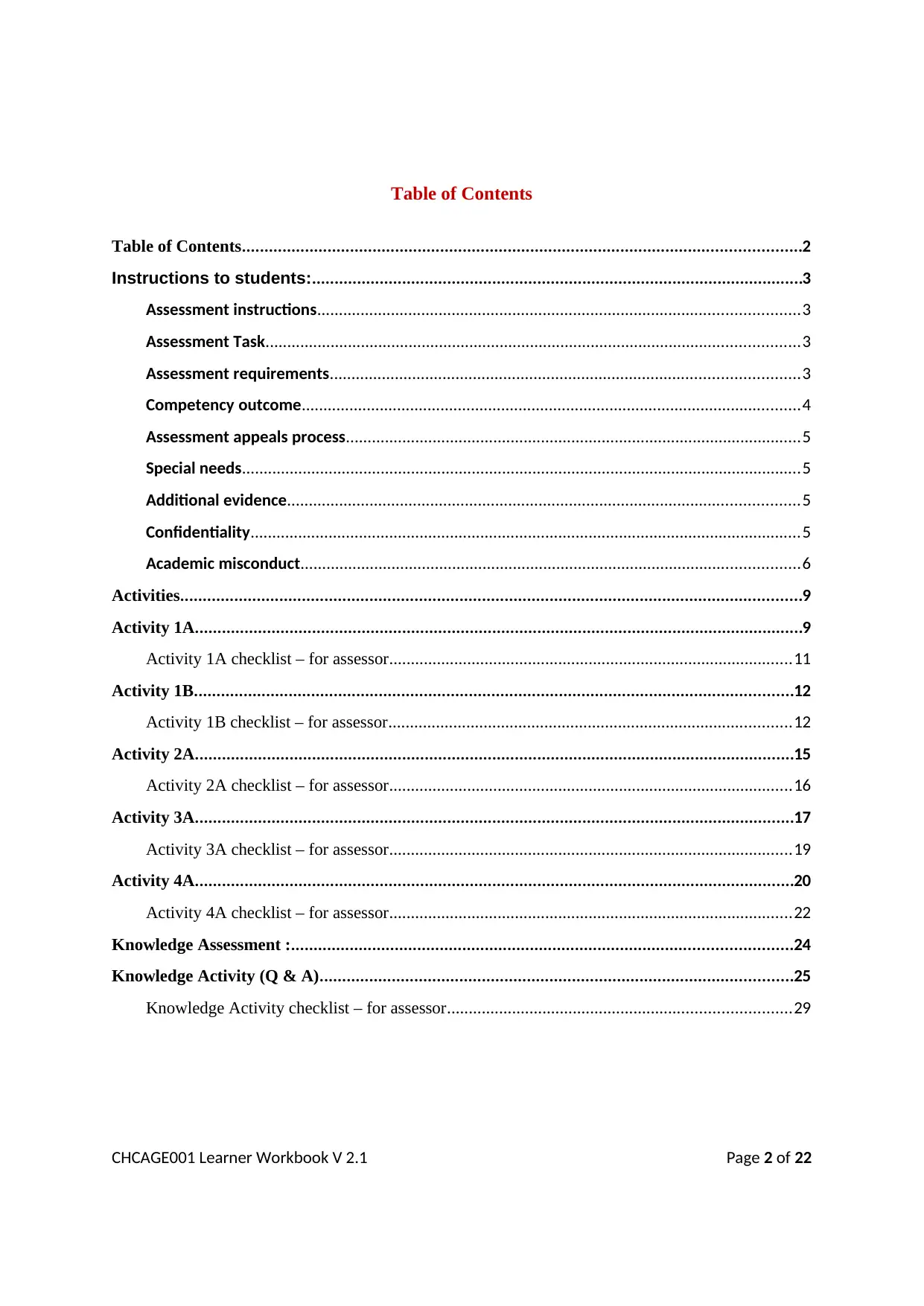
Table of Contents
Table of Contents............................................................................................................................2
Instructions to students:.............................................................................................................3
Assessment instructions...............................................................................................................3
Assessment Task...........................................................................................................................3
Assessment requirements............................................................................................................3
Competency outcome...................................................................................................................4
Assessment appeals process.........................................................................................................5
Special needs.................................................................................................................................5
Additional evidence......................................................................................................................5
Confidentiality...............................................................................................................................5
Academic misconduct...................................................................................................................6
Activities..........................................................................................................................................9
Activity 1A.......................................................................................................................................9
Activity 1A checklist – for assessor.............................................................................................11
Activity 1B.....................................................................................................................................12
Activity 1B checklist – for assessor.............................................................................................12
Activity 2A.....................................................................................................................................15
Activity 2A checklist – for assessor.............................................................................................16
Activity 3A.....................................................................................................................................17
Activity 3A checklist – for assessor.............................................................................................19
Activity 4A.....................................................................................................................................20
Activity 4A checklist – for assessor.............................................................................................22
Knowledge Assessment :...............................................................................................................24
Knowledge Activity (Q & A).........................................................................................................25
Knowledge Activity checklist – for assessor...............................................................................29
CHCAGE001 Learner Workbook V 2.1 Page 2 of 22
Table of Contents............................................................................................................................2
Instructions to students:.............................................................................................................3
Assessment instructions...............................................................................................................3
Assessment Task...........................................................................................................................3
Assessment requirements............................................................................................................3
Competency outcome...................................................................................................................4
Assessment appeals process.........................................................................................................5
Special needs.................................................................................................................................5
Additional evidence......................................................................................................................5
Confidentiality...............................................................................................................................5
Academic misconduct...................................................................................................................6
Activities..........................................................................................................................................9
Activity 1A.......................................................................................................................................9
Activity 1A checklist – for assessor.............................................................................................11
Activity 1B.....................................................................................................................................12
Activity 1B checklist – for assessor.............................................................................................12
Activity 2A.....................................................................................................................................15
Activity 2A checklist – for assessor.............................................................................................16
Activity 3A.....................................................................................................................................17
Activity 3A checklist – for assessor.............................................................................................19
Activity 4A.....................................................................................................................................20
Activity 4A checklist – for assessor.............................................................................................22
Knowledge Assessment :...............................................................................................................24
Knowledge Activity (Q & A).........................................................................................................25
Knowledge Activity checklist – for assessor...............................................................................29
CHCAGE001 Learner Workbook V 2.1 Page 2 of 22
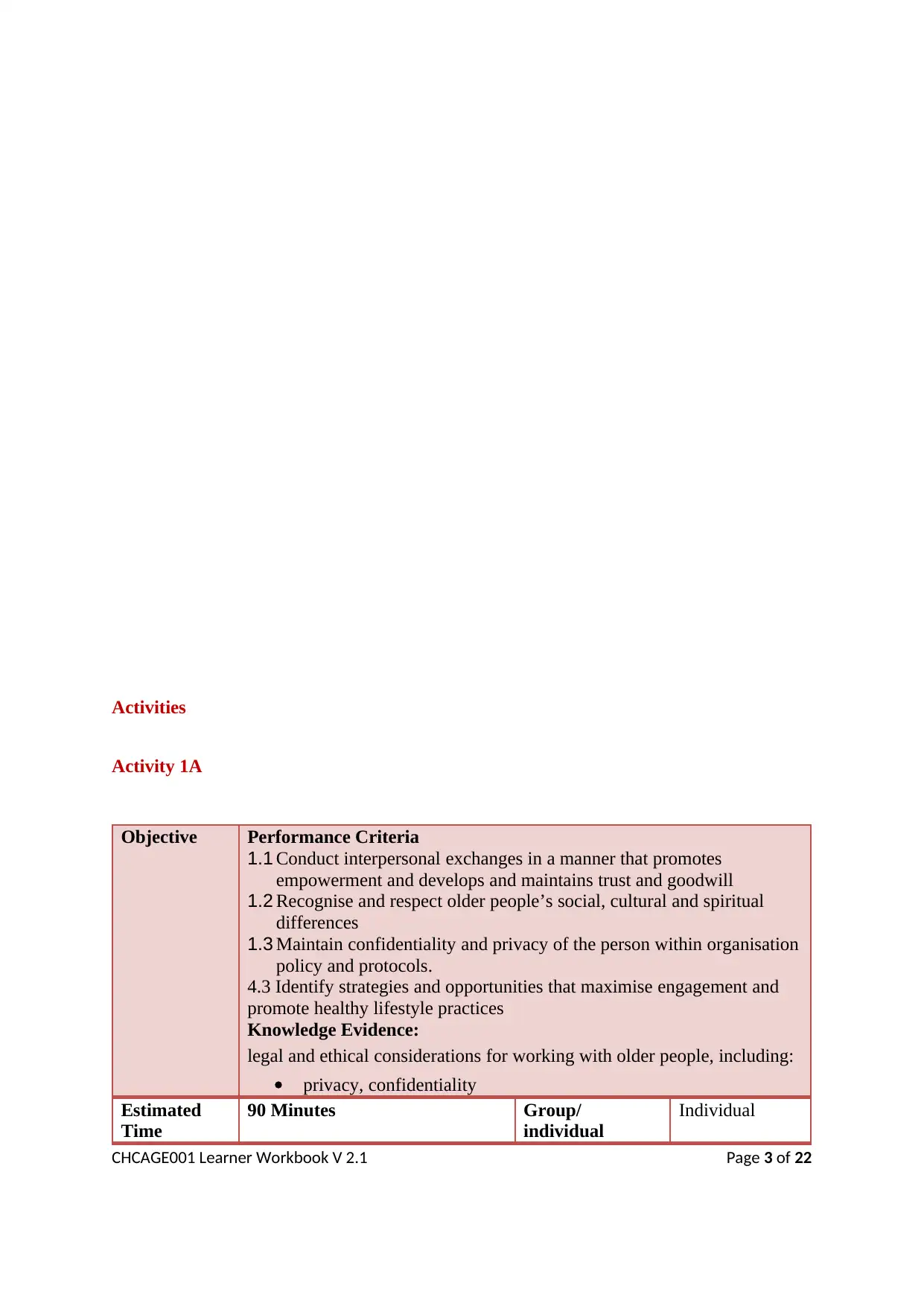
Activities
Activity 1A
Objective Performance Criteria
1.1 Conduct interpersonal exchanges in a manner that promotes
empowerment and develops and maintains trust and goodwill
1.2 Recognise and respect older people’s social, cultural and spiritual
differences
1.3 Maintain confidentiality and privacy of the person within organisation
policy and protocols.
4.3 Identify strategies and opportunities that maximise engagement and
promote healthy lifestyle practices
Knowledge Evidence:
legal and ethical considerations for working with older people, including:
privacy, confidentiality
Estimated
Time
90 Minutes Group/
individual
Individual
CHCAGE001 Learner Workbook V 2.1 Page 3 of 22
Activity 1A
Objective Performance Criteria
1.1 Conduct interpersonal exchanges in a manner that promotes
empowerment and develops and maintains trust and goodwill
1.2 Recognise and respect older people’s social, cultural and spiritual
differences
1.3 Maintain confidentiality and privacy of the person within organisation
policy and protocols.
4.3 Identify strategies and opportunities that maximise engagement and
promote healthy lifestyle practices
Knowledge Evidence:
legal and ethical considerations for working with older people, including:
privacy, confidentiality
Estimated
Time
90 Minutes Group/
individual
Individual
CHCAGE001 Learner Workbook V 2.1 Page 3 of 22
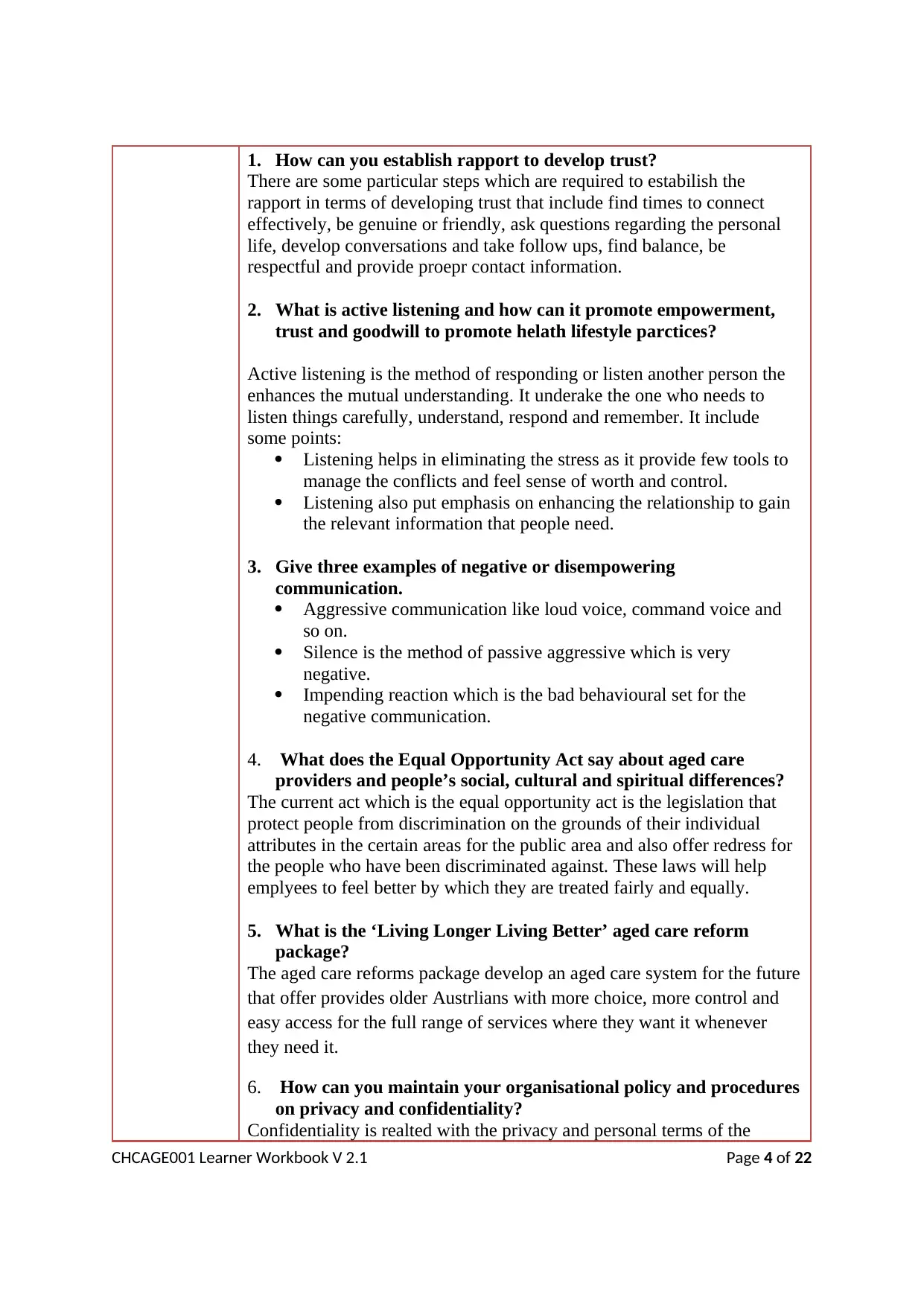
1. How can you establish rapport to develop trust?
There are some particular steps which are required to estabilish the
rapport in terms of developing trust that include find times to connect
effectively, be genuine or friendly, ask questions regarding the personal
life, develop conversations and take follow ups, find balance, be
respectful and provide proepr contact information.
2. What is active listening and how can it promote empowerment,
trust and goodwill to promote helath lifestyle parctices?
Active listening is the method of responding or listen another person the
enhances the mutual understanding. It underake the one who needs to
listen things carefully, understand, respond and remember. It include
some points:
Listening helps in eliminating the stress as it provide few tools to
manage the conflicts and feel sense of worth and control.
Listening also put emphasis on enhancing the relationship to gain
the relevant information that people need.
3. Give three examples of negative or disempowering
communication.
Aggressive communication like loud voice, command voice and
so on.
Silence is the method of passive aggressive which is very
negative.
Impending reaction which is the bad behavioural set for the
negative communication.
4. What does the Equal Opportunity Act say about aged care
providers and people’s social, cultural and spiritual differences?
The current act which is the equal opportunity act is the legislation that
protect people from discrimination on the grounds of their individual
attributes in the certain areas for the public area and also offer redress for
the people who have been discriminated against. These laws will help
emplyees to feel better by which they are treated fairly and equally.
5. What is the ‘Living Longer Living Better’ aged care reform
package?
The aged care reforms package develop an aged care system for the future
that offer provides older Austrlians with more choice, more control and
easy access for the full range of services where they want it whenever
they need it.
6. How can you maintain your organisational policy and procedures
on privacy and confidentiality?
Confidentiality is realted with the privacy and personal terms of the
CHCAGE001 Learner Workbook V 2.1 Page 4 of 22
There are some particular steps which are required to estabilish the
rapport in terms of developing trust that include find times to connect
effectively, be genuine or friendly, ask questions regarding the personal
life, develop conversations and take follow ups, find balance, be
respectful and provide proepr contact information.
2. What is active listening and how can it promote empowerment,
trust and goodwill to promote helath lifestyle parctices?
Active listening is the method of responding or listen another person the
enhances the mutual understanding. It underake the one who needs to
listen things carefully, understand, respond and remember. It include
some points:
Listening helps in eliminating the stress as it provide few tools to
manage the conflicts and feel sense of worth and control.
Listening also put emphasis on enhancing the relationship to gain
the relevant information that people need.
3. Give three examples of negative or disempowering
communication.
Aggressive communication like loud voice, command voice and
so on.
Silence is the method of passive aggressive which is very
negative.
Impending reaction which is the bad behavioural set for the
negative communication.
4. What does the Equal Opportunity Act say about aged care
providers and people’s social, cultural and spiritual differences?
The current act which is the equal opportunity act is the legislation that
protect people from discrimination on the grounds of their individual
attributes in the certain areas for the public area and also offer redress for
the people who have been discriminated against. These laws will help
emplyees to feel better by which they are treated fairly and equally.
5. What is the ‘Living Longer Living Better’ aged care reform
package?
The aged care reforms package develop an aged care system for the future
that offer provides older Austrlians with more choice, more control and
easy access for the full range of services where they want it whenever
they need it.
6. How can you maintain your organisational policy and procedures
on privacy and confidentiality?
Confidentiality is realted with the privacy and personal terms of the
CHCAGE001 Learner Workbook V 2.1 Page 4 of 22
Secure Best Marks with AI Grader
Need help grading? Try our AI Grader for instant feedback on your assignments.
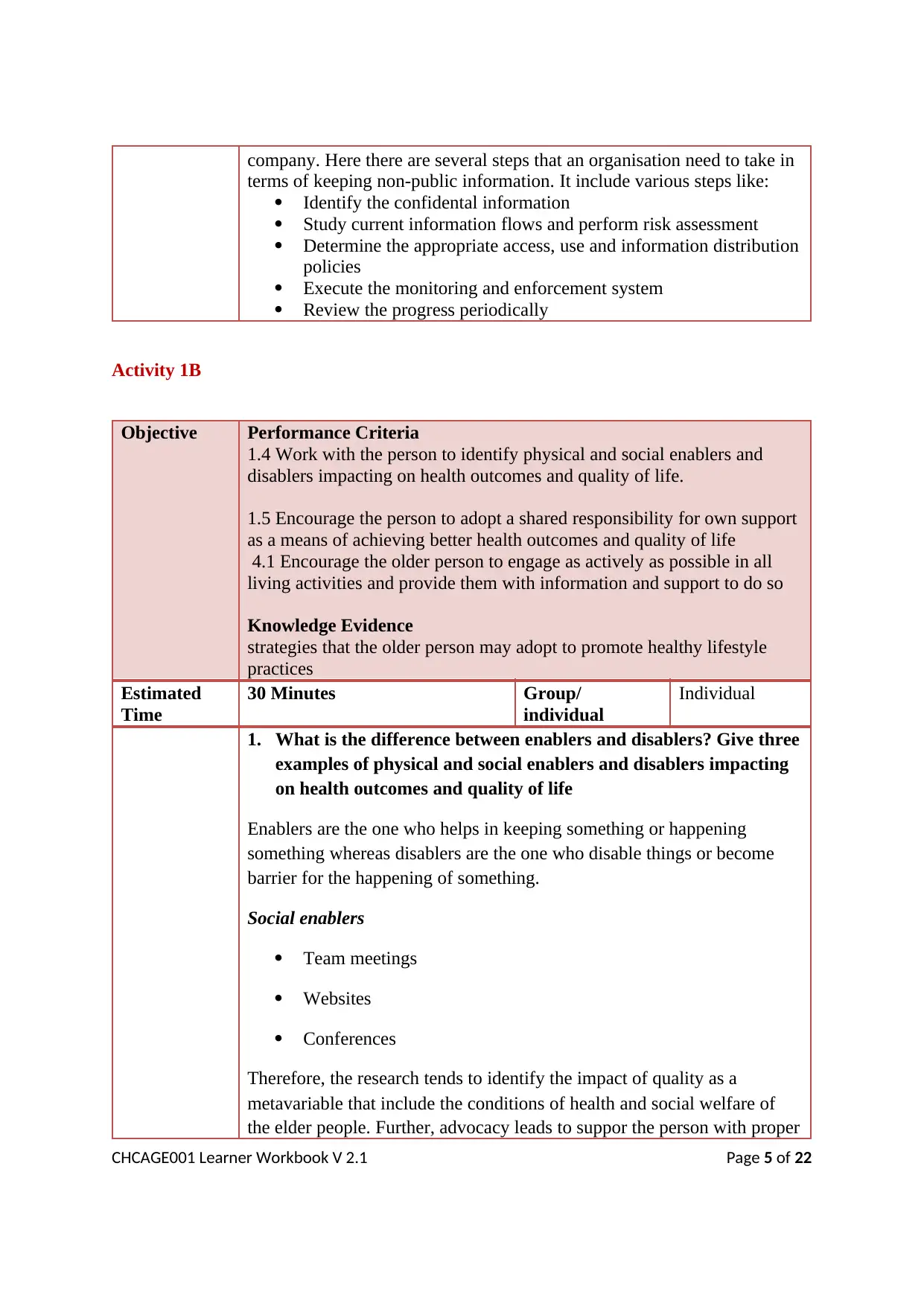
company. Here there are several steps that an organisation need to take in
terms of keeping non-public information. It include various steps like:
Identify the confidental information
Study current information flows and perform risk assessment
Determine the appropriate access, use and information distribution
policies
Execute the monitoring and enforcement system
Review the progress periodically
Activity 1B
Objective Performance Criteria
1.4 Work with the person to identify physical and social enablers and
disablers impacting on health outcomes and quality of life.
1.5 Encourage the person to adopt a shared responsibility for own support
as a means of achieving better health outcomes and quality of life
4.1 Encourage the older person to engage as actively as possible in all
living activities and provide them with information and support to do so
Knowledge Evidence
strategies that the older person may adopt to promote healthy lifestyle
practices
Estimated
Time
30 Minutes Group/
individual
Individual
1. What is the difference between enablers and disablers? Give three
examples of physical and social enablers and disablers impacting
on health outcomes and quality of life
Enablers are the one who helps in keeping something or happening
something whereas disablers are the one who disable things or become
barrier for the happening of something.
Social enablers
Team meetings
Websites
Conferences
Therefore, the research tends to identify the impact of quality as a
metavariable that include the conditions of health and social welfare of
the elder people. Further, advocacy leads to suppor the person with proper
CHCAGE001 Learner Workbook V 2.1 Page 5 of 22
terms of keeping non-public information. It include various steps like:
Identify the confidental information
Study current information flows and perform risk assessment
Determine the appropriate access, use and information distribution
policies
Execute the monitoring and enforcement system
Review the progress periodically
Activity 1B
Objective Performance Criteria
1.4 Work with the person to identify physical and social enablers and
disablers impacting on health outcomes and quality of life.
1.5 Encourage the person to adopt a shared responsibility for own support
as a means of achieving better health outcomes and quality of life
4.1 Encourage the older person to engage as actively as possible in all
living activities and provide them with information and support to do so
Knowledge Evidence
strategies that the older person may adopt to promote healthy lifestyle
practices
Estimated
Time
30 Minutes Group/
individual
Individual
1. What is the difference between enablers and disablers? Give three
examples of physical and social enablers and disablers impacting
on health outcomes and quality of life
Enablers are the one who helps in keeping something or happening
something whereas disablers are the one who disable things or become
barrier for the happening of something.
Social enablers
Team meetings
Websites
Conferences
Therefore, the research tends to identify the impact of quality as a
metavariable that include the conditions of health and social welfare of
the elder people. Further, advocacy leads to suppor the person with proper
CHCAGE001 Learner Workbook V 2.1 Page 5 of 22
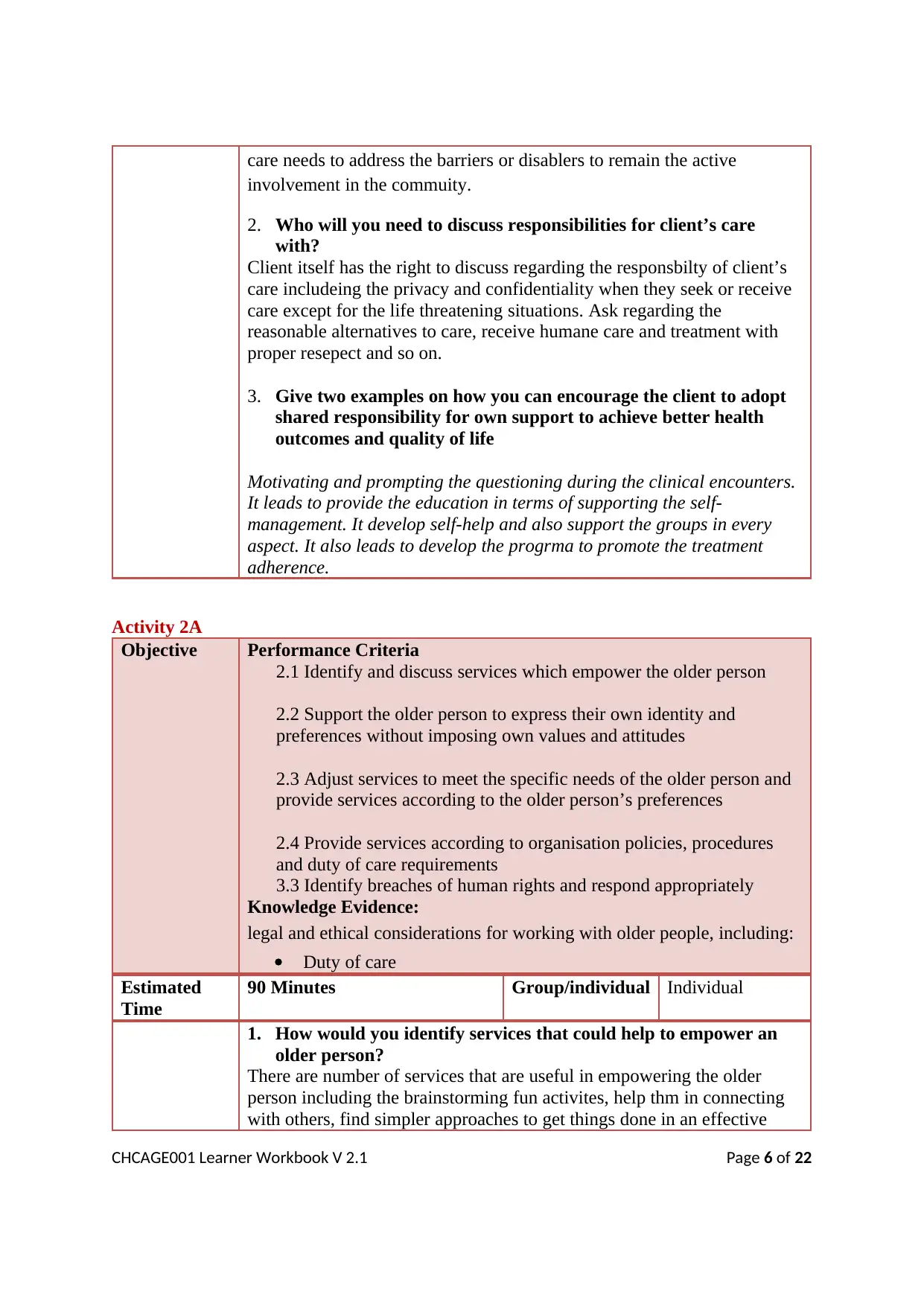
care needs to address the barriers or disablers to remain the active
involvement in the commuity.
2. Who will you need to discuss responsibilities for client’s care
with?
Client itself has the right to discuss regarding the responsbilty of client’s
care includeing the privacy and confidentiality when they seek or receive
care except for the life threatening situations. Ask regarding the
reasonable alternatives to care, receive humane care and treatment with
proper resepect and so on.
3. Give two examples on how you can encourage the client to adopt
shared responsibility for own support to achieve better health
outcomes and quality of life
Motivating and prompting the questioning during the clinical encounters.
It leads to provide the education in terms of supporting the self-
management. It develop self-help and also support the groups in every
aspect. It also leads to develop the progrma to promote the treatment
adherence.
Activity 2A
Objective Performance Criteria
2.1 Identify and discuss services which empower the older person
2.2 Support the older person to express their own identity and
preferences without imposing own values and attitudes
2.3 Adjust services to meet the specific needs of the older person and
provide services according to the older person’s preferences
2.4 Provide services according to organisation policies, procedures
and duty of care requirements
3.3 Identify breaches of human rights and respond appropriately
Knowledge Evidence:
legal and ethical considerations for working with older people, including:
Duty of care
Estimated
Time
90 Minutes Group/individual Individual
1. How would you identify services that could help to empower an
older person?
There are number of services that are useful in empowering the older
person including the brainstorming fun activites, help thm in connecting
with others, find simpler approaches to get things done in an effective
CHCAGE001 Learner Workbook V 2.1 Page 6 of 22
involvement in the commuity.
2. Who will you need to discuss responsibilities for client’s care
with?
Client itself has the right to discuss regarding the responsbilty of client’s
care includeing the privacy and confidentiality when they seek or receive
care except for the life threatening situations. Ask regarding the
reasonable alternatives to care, receive humane care and treatment with
proper resepect and so on.
3. Give two examples on how you can encourage the client to adopt
shared responsibility for own support to achieve better health
outcomes and quality of life
Motivating and prompting the questioning during the clinical encounters.
It leads to provide the education in terms of supporting the self-
management. It develop self-help and also support the groups in every
aspect. It also leads to develop the progrma to promote the treatment
adherence.
Activity 2A
Objective Performance Criteria
2.1 Identify and discuss services which empower the older person
2.2 Support the older person to express their own identity and
preferences without imposing own values and attitudes
2.3 Adjust services to meet the specific needs of the older person and
provide services according to the older person’s preferences
2.4 Provide services according to organisation policies, procedures
and duty of care requirements
3.3 Identify breaches of human rights and respond appropriately
Knowledge Evidence:
legal and ethical considerations for working with older people, including:
Duty of care
Estimated
Time
90 Minutes Group/individual Individual
1. How would you identify services that could help to empower an
older person?
There are number of services that are useful in empowering the older
person including the brainstorming fun activites, help thm in connecting
with others, find simpler approaches to get things done in an effective
CHCAGE001 Learner Workbook V 2.1 Page 6 of 22
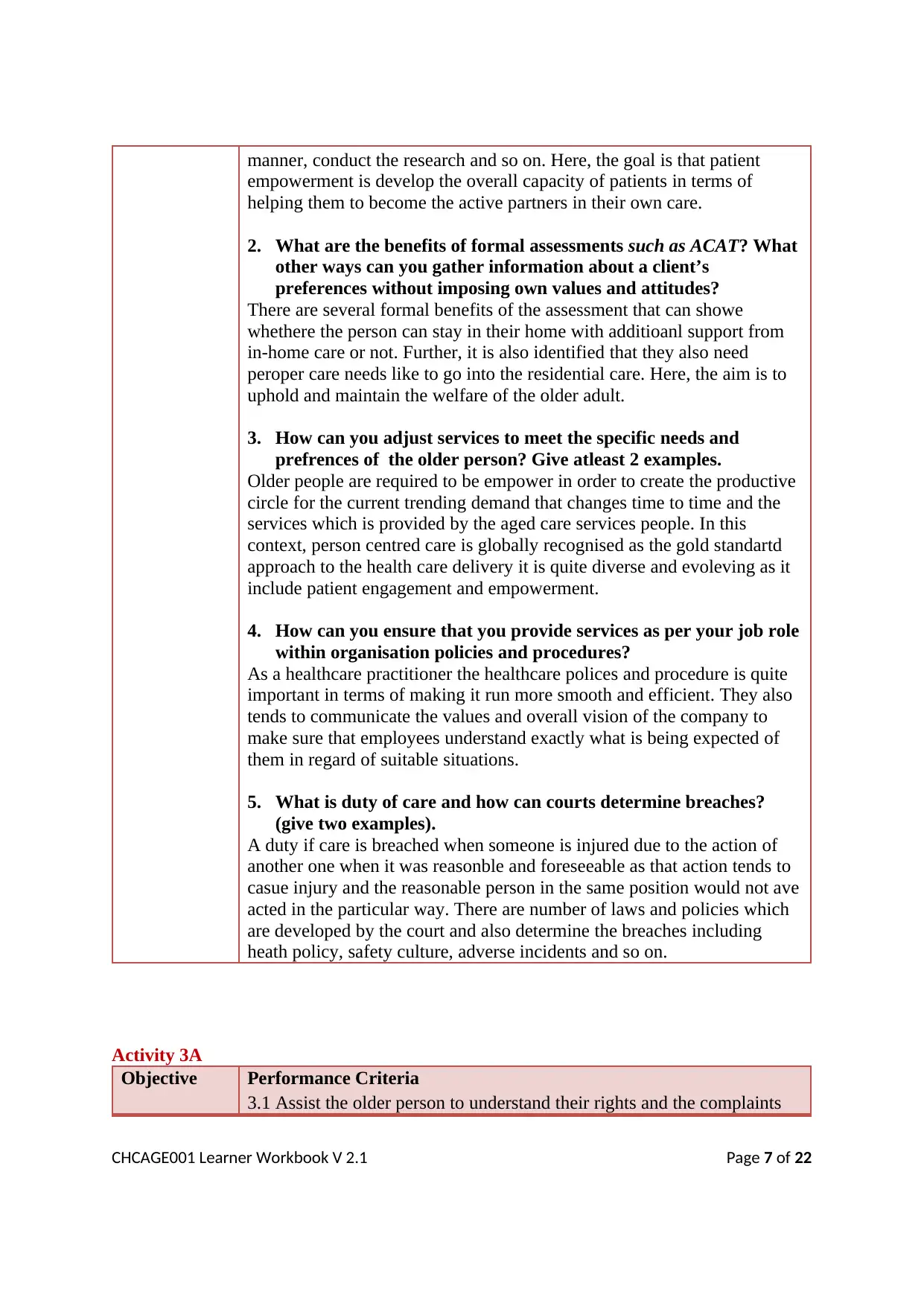
manner, conduct the research and so on. Here, the goal is that patient
empowerment is develop the overall capacity of patients in terms of
helping them to become the active partners in their own care.
2. What are the benefits of formal assessments such as ACAT? What
other ways can you gather information about a client’s
preferences without imposing own values and attitudes?
There are several formal benefits of the assessment that can showe
whethere the person can stay in their home with additioanl support from
in-home care or not. Further, it is also identified that they also need
peroper care needs like to go into the residential care. Here, the aim is to
uphold and maintain the welfare of the older adult.
3. How can you adjust services to meet the specific needs and
prefrences of the older person? Give atleast 2 examples.
Older people are required to be empower in order to create the productive
circle for the current trending demand that changes time to time and the
services which is provided by the aged care services people. In this
context, person centred care is globally recognised as the gold standartd
approach to the health care delivery it is quite diverse and evoleving as it
include patient engagement and empowerment.
4. How can you ensure that you provide services as per your job role
within organisation policies and procedures?
As a healthcare practitioner the healthcare polices and procedure is quite
important in terms of making it run more smooth and efficient. They also
tends to communicate the values and overall vision of the company to
make sure that employees understand exactly what is being expected of
them in regard of suitable situations.
5. What is duty of care and how can courts determine breaches?
(give two examples).
A duty if care is breached when someone is injured due to the action of
another one when it was reasonble and foreseeable as that action tends to
casue injury and the reasonable person in the same position would not ave
acted in the particular way. There are number of laws and policies which
are developed by the court and also determine the breaches including
heath policy, safety culture, adverse incidents and so on.
Activity 3A
Objective Performance Criteria
3.1 Assist the older person to understand their rights and the complaints
CHCAGE001 Learner Workbook V 2.1 Page 7 of 22
empowerment is develop the overall capacity of patients in terms of
helping them to become the active partners in their own care.
2. What are the benefits of formal assessments such as ACAT? What
other ways can you gather information about a client’s
preferences without imposing own values and attitudes?
There are several formal benefits of the assessment that can showe
whethere the person can stay in their home with additioanl support from
in-home care or not. Further, it is also identified that they also need
peroper care needs like to go into the residential care. Here, the aim is to
uphold and maintain the welfare of the older adult.
3. How can you adjust services to meet the specific needs and
prefrences of the older person? Give atleast 2 examples.
Older people are required to be empower in order to create the productive
circle for the current trending demand that changes time to time and the
services which is provided by the aged care services people. In this
context, person centred care is globally recognised as the gold standartd
approach to the health care delivery it is quite diverse and evoleving as it
include patient engagement and empowerment.
4. How can you ensure that you provide services as per your job role
within organisation policies and procedures?
As a healthcare practitioner the healthcare polices and procedure is quite
important in terms of making it run more smooth and efficient. They also
tends to communicate the values and overall vision of the company to
make sure that employees understand exactly what is being expected of
them in regard of suitable situations.
5. What is duty of care and how can courts determine breaches?
(give two examples).
A duty if care is breached when someone is injured due to the action of
another one when it was reasonble and foreseeable as that action tends to
casue injury and the reasonable person in the same position would not ave
acted in the particular way. There are number of laws and policies which
are developed by the court and also determine the breaches including
heath policy, safety culture, adverse incidents and so on.
Activity 3A
Objective Performance Criteria
3.1 Assist the older person to understand their rights and the complaints
CHCAGE001 Learner Workbook V 2.1 Page 7 of 22
Paraphrase This Document
Need a fresh take? Get an instant paraphrase of this document with our AI Paraphraser
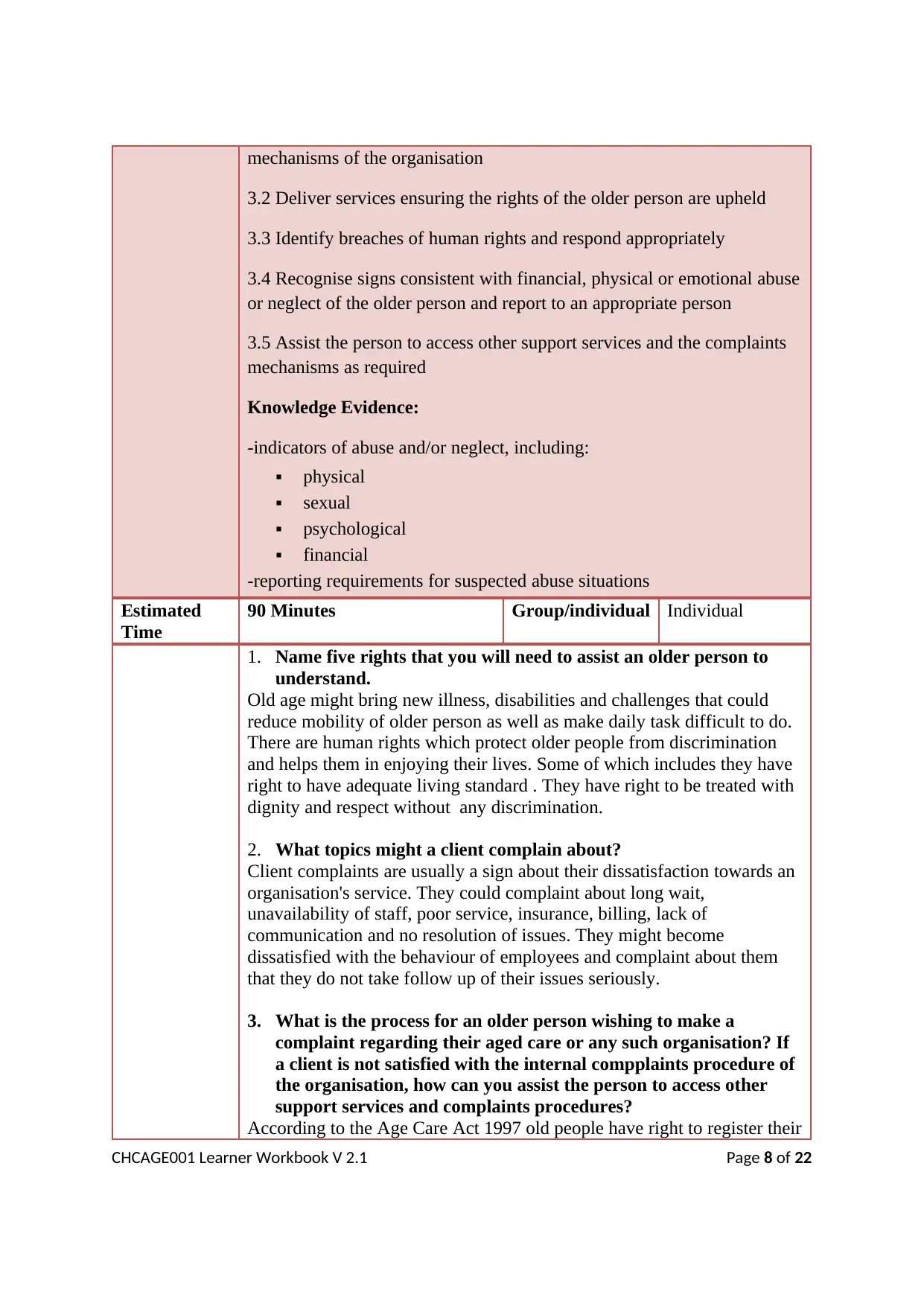
mechanisms of the organisation
3.2 Deliver services ensuring the rights of the older person are upheld
3.3 Identify breaches of human rights and respond appropriately
3.4 Recognise signs consistent with financial, physical or emotional abuse
or neglect of the older person and report to an appropriate person
3.5 Assist the person to access other support services and the complaints
mechanisms as required
Knowledge Evidence:
-indicators of abuse and/or neglect, including:
physical
sexual
psychological
financial
-reporting requirements for suspected abuse situations
Estimated
Time
90 Minutes Group/individual Individual
1. Name five rights that you will need to assist an older person to
understand.
Old age might bring new illness, disabilities and challenges that could
reduce mobility of older person as well as make daily task difficult to do.
There are human rights which protect older people from discrimination
and helps them in enjoying their lives. Some of which includes they have
right to have adequate living standard . They have right to be treated with
dignity and respect without any discrimination.
2. What topics might a client complain about?
Client complaints are usually a sign about their dissatisfaction towards an
organisation's service. They could complaint about long wait,
unavailability of staff, poor service, insurance, billing, lack of
communication and no resolution of issues. They might become
dissatisfied with the behaviour of employees and complaint about them
that they do not take follow up of their issues seriously.
3. What is the process for an older person wishing to make a
complaint regarding their aged care or any such organisation? If
a client is not satisfied with the internal compplaints procedure of
the organisation, how can you assist the person to access other
support services and complaints procedures?
According to the Age Care Act 1997 old people have right to register their
CHCAGE001 Learner Workbook V 2.1 Page 8 of 22
3.2 Deliver services ensuring the rights of the older person are upheld
3.3 Identify breaches of human rights and respond appropriately
3.4 Recognise signs consistent with financial, physical or emotional abuse
or neglect of the older person and report to an appropriate person
3.5 Assist the person to access other support services and the complaints
mechanisms as required
Knowledge Evidence:
-indicators of abuse and/or neglect, including:
physical
sexual
psychological
financial
-reporting requirements for suspected abuse situations
Estimated
Time
90 Minutes Group/individual Individual
1. Name five rights that you will need to assist an older person to
understand.
Old age might bring new illness, disabilities and challenges that could
reduce mobility of older person as well as make daily task difficult to do.
There are human rights which protect older people from discrimination
and helps them in enjoying their lives. Some of which includes they have
right to have adequate living standard . They have right to be treated with
dignity and respect without any discrimination.
2. What topics might a client complain about?
Client complaints are usually a sign about their dissatisfaction towards an
organisation's service. They could complaint about long wait,
unavailability of staff, poor service, insurance, billing, lack of
communication and no resolution of issues. They might become
dissatisfied with the behaviour of employees and complaint about them
that they do not take follow up of their issues seriously.
3. What is the process for an older person wishing to make a
complaint regarding their aged care or any such organisation? If
a client is not satisfied with the internal compplaints procedure of
the organisation, how can you assist the person to access other
support services and complaints procedures?
According to the Age Care Act 1997 old people have right to register their
CHCAGE001 Learner Workbook V 2.1 Page 8 of 22

issues regarding their aged care services. They could contact to the senior
manager of organisation or if they feel shy they can get someone to help
them. And if they are not satisfied with internal complaints procedures
than they can call to Aged Care Quality and safety commission directly.
4. What are the five major rights that older people have, regarding
care? Give an example for each to demonstarte that the services
delivered or care provided ensures the right of older people are
upheld.
The five major rights of older people regarding their care are
independence, participation, care, self-fulfilment and dignity. The older
people are encouraged to do their daily task by themselves to make them
independent. They are motivated to take participation in social activities
so that they could feel a sense of belonging. They are taken care of by
following all safety measures and hygiene procedure. People make them
involve in activities such as crafting which makes older people happy.
They are treated with respect and no discrimination occurs at care centres.
5. How would you respond if you witnessed or knew an older
person's rights were being violated?
If a person detects any abuse against older people then they can take
measures such as first identify signs that indicates violation of their rights.
They can provide emotional support to older people and could make plan
for their safety. The person could call to emergency services or write
down their concerns in details to official authorities.
6. Define elderly abuse. Give examples of the signs consistent with
each of the following : financial, physical or emotional abuse or
neglect of the older person?
Elder abuse is described when some people harm or neglect old persons
above the age of 60. The types of elder abuse includes physical abuse
which includes injuring them physically such as kicking, shoving or
burning. Emotional abuse includes when other yells on them or threatens,
ignore their opinions and controls their actions. Financial abuse involves
when people takes their money or does not lend them money even for
their daily tasks.
7. What are your organisation's guidelines for responding to elderly
abuse cases?
The guideline in response to elderly abuse procedure includes that
complaints must be register at management committee. The person must
be restrained with consent of a medical staff to ensure that individual
safety. When a person is restrained the management must inform their
relatives. All issues must be recorded in complaint register. The
CHCAGE001 Learner Workbook V 2.1 Page 9 of 22
manager of organisation or if they feel shy they can get someone to help
them. And if they are not satisfied with internal complaints procedures
than they can call to Aged Care Quality and safety commission directly.
4. What are the five major rights that older people have, regarding
care? Give an example for each to demonstarte that the services
delivered or care provided ensures the right of older people are
upheld.
The five major rights of older people regarding their care are
independence, participation, care, self-fulfilment and dignity. The older
people are encouraged to do their daily task by themselves to make them
independent. They are motivated to take participation in social activities
so that they could feel a sense of belonging. They are taken care of by
following all safety measures and hygiene procedure. People make them
involve in activities such as crafting which makes older people happy.
They are treated with respect and no discrimination occurs at care centres.
5. How would you respond if you witnessed or knew an older
person's rights were being violated?
If a person detects any abuse against older people then they can take
measures such as first identify signs that indicates violation of their rights.
They can provide emotional support to older people and could make plan
for their safety. The person could call to emergency services or write
down their concerns in details to official authorities.
6. Define elderly abuse. Give examples of the signs consistent with
each of the following : financial, physical or emotional abuse or
neglect of the older person?
Elder abuse is described when some people harm or neglect old persons
above the age of 60. The types of elder abuse includes physical abuse
which includes injuring them physically such as kicking, shoving or
burning. Emotional abuse includes when other yells on them or threatens,
ignore their opinions and controls their actions. Financial abuse involves
when people takes their money or does not lend them money even for
their daily tasks.
7. What are your organisation's guidelines for responding to elderly
abuse cases?
The guideline in response to elderly abuse procedure includes that
complaints must be register at management committee. The person must
be restrained with consent of a medical staff to ensure that individual
safety. When a person is restrained the management must inform their
relatives. All issues must be recorded in complaint register. The
CHCAGE001 Learner Workbook V 2.1 Page 9 of 22
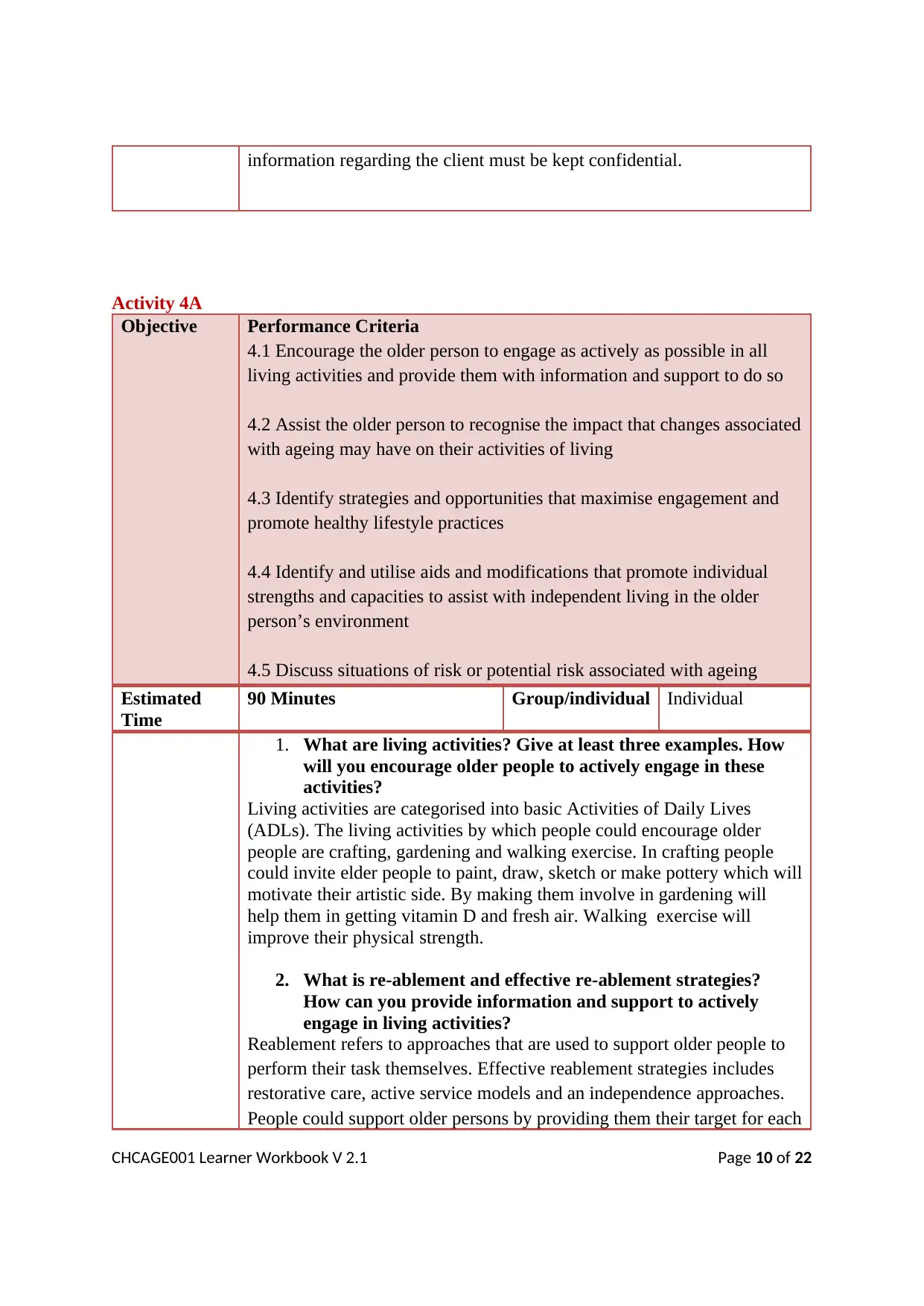
information regarding the client must be kept confidential.
Activity 4A
Objective Performance Criteria
4.1 Encourage the older person to engage as actively as possible in all
living activities and provide them with information and support to do so
4.2 Assist the older person to recognise the impact that changes associated
with ageing may have on their activities of living
4.3 Identify strategies and opportunities that maximise engagement and
promote healthy lifestyle practices
4.4 Identify and utilise aids and modifications that promote individual
strengths and capacities to assist with independent living in the older
person’s environment
4.5 Discuss situations of risk or potential risk associated with ageing
Estimated
Time
90 Minutes Group/individual Individual
1. What are living activities? Give at least three examples. How
will you encourage older people to actively engage in these
activities?
Living activities are categorised into basic Activities of Daily Lives
(ADLs). The living activities by which people could encourage older
people are crafting, gardening and walking exercise. In crafting people
could invite elder people to paint, draw, sketch or make pottery which will
motivate their artistic side. By making them involve in gardening will
help them in getting vitamin D and fresh air. Walking exercise will
improve their physical strength.
2. What is re-ablement and effective re-ablement strategies?
How can you provide information and support to actively
engage in living activities?
Reablement refers to approaches that are used to support older people to
perform their task themselves. Effective reablement strategies includes
restorative care, active service models and an independence approaches.
People could support older persons by providing them their target for each
CHCAGE001 Learner Workbook V 2.1 Page 10 of 22
Activity 4A
Objective Performance Criteria
4.1 Encourage the older person to engage as actively as possible in all
living activities and provide them with information and support to do so
4.2 Assist the older person to recognise the impact that changes associated
with ageing may have on their activities of living
4.3 Identify strategies and opportunities that maximise engagement and
promote healthy lifestyle practices
4.4 Identify and utilise aids and modifications that promote individual
strengths and capacities to assist with independent living in the older
person’s environment
4.5 Discuss situations of risk or potential risk associated with ageing
Estimated
Time
90 Minutes Group/individual Individual
1. What are living activities? Give at least three examples. How
will you encourage older people to actively engage in these
activities?
Living activities are categorised into basic Activities of Daily Lives
(ADLs). The living activities by which people could encourage older
people are crafting, gardening and walking exercise. In crafting people
could invite elder people to paint, draw, sketch or make pottery which will
motivate their artistic side. By making them involve in gardening will
help them in getting vitamin D and fresh air. Walking exercise will
improve their physical strength.
2. What is re-ablement and effective re-ablement strategies?
How can you provide information and support to actively
engage in living activities?
Reablement refers to approaches that are used to support older people to
perform their task themselves. Effective reablement strategies includes
restorative care, active service models and an independence approaches.
People could support older persons by providing them their target for each
CHCAGE001 Learner Workbook V 2.1 Page 10 of 22
Secure Best Marks with AI Grader
Need help grading? Try our AI Grader for instant feedback on your assignments.
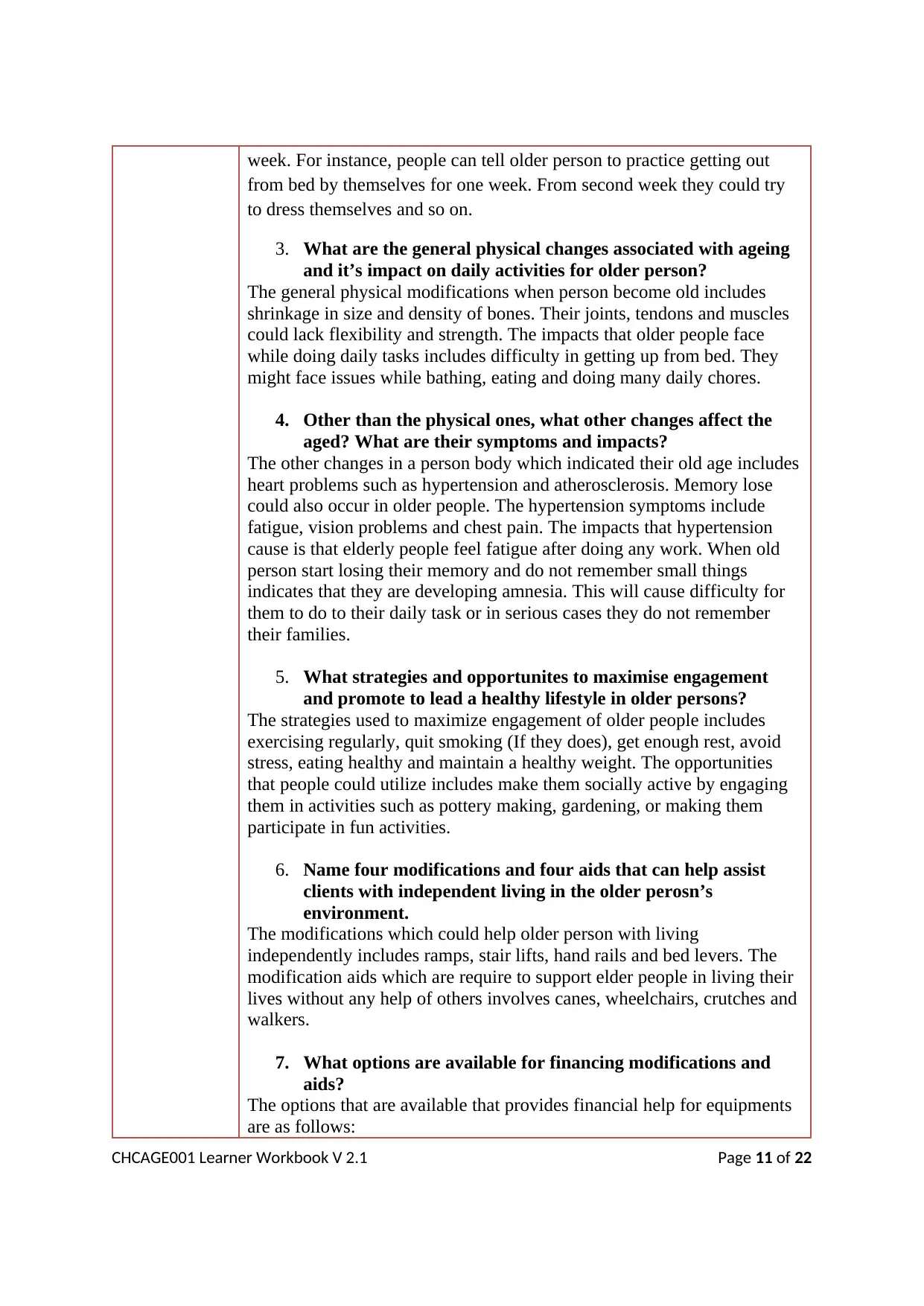
week. For instance, people can tell older person to practice getting out
from bed by themselves for one week. From second week they could try
to dress themselves and so on.
3. What are the general physical changes associated with ageing
and it’s impact on daily activities for older person?
The general physical modifications when person become old includes
shrinkage in size and density of bones. Their joints, tendons and muscles
could lack flexibility and strength. The impacts that older people face
while doing daily tasks includes difficulty in getting up from bed. They
might face issues while bathing, eating and doing many daily chores.
4. Other than the physical ones, what other changes affect the
aged? What are their symptoms and impacts?
The other changes in a person body which indicated their old age includes
heart problems such as hypertension and atherosclerosis. Memory lose
could also occur in older people. The hypertension symptoms include
fatigue, vision problems and chest pain. The impacts that hypertension
cause is that elderly people feel fatigue after doing any work. When old
person start losing their memory and do not remember small things
indicates that they are developing amnesia. This will cause difficulty for
them to do to their daily task or in serious cases they do not remember
their families.
5. What strategies and opportunites to maximise engagement
and promote to lead a healthy lifestyle in older persons?
The strategies used to maximize engagement of older people includes
exercising regularly, quit smoking (If they does), get enough rest, avoid
stress, eating healthy and maintain a healthy weight. The opportunities
that people could utilize includes make them socially active by engaging
them in activities such as pottery making, gardening, or making them
participate in fun activities.
6. Name four modifications and four aids that can help assist
clients with independent living in the older perosn’s
environment.
The modifications which could help older person with living
independently includes ramps, stair lifts, hand rails and bed levers. The
modification aids which are require to support elder people in living their
lives without any help of others involves canes, wheelchairs, crutches and
walkers.
7. What options are available for financing modifications and
aids?
The options that are available that provides financial help for equipments
are as follows:
CHCAGE001 Learner Workbook V 2.1 Page 11 of 22
from bed by themselves for one week. From second week they could try
to dress themselves and so on.
3. What are the general physical changes associated with ageing
and it’s impact on daily activities for older person?
The general physical modifications when person become old includes
shrinkage in size and density of bones. Their joints, tendons and muscles
could lack flexibility and strength. The impacts that older people face
while doing daily tasks includes difficulty in getting up from bed. They
might face issues while bathing, eating and doing many daily chores.
4. Other than the physical ones, what other changes affect the
aged? What are their symptoms and impacts?
The other changes in a person body which indicated their old age includes
heart problems such as hypertension and atherosclerosis. Memory lose
could also occur in older people. The hypertension symptoms include
fatigue, vision problems and chest pain. The impacts that hypertension
cause is that elderly people feel fatigue after doing any work. When old
person start losing their memory and do not remember small things
indicates that they are developing amnesia. This will cause difficulty for
them to do to their daily task or in serious cases they do not remember
their families.
5. What strategies and opportunites to maximise engagement
and promote to lead a healthy lifestyle in older persons?
The strategies used to maximize engagement of older people includes
exercising regularly, quit smoking (If they does), get enough rest, avoid
stress, eating healthy and maintain a healthy weight. The opportunities
that people could utilize includes make them socially active by engaging
them in activities such as pottery making, gardening, or making them
participate in fun activities.
6. Name four modifications and four aids that can help assist
clients with independent living in the older perosn’s
environment.
The modifications which could help older person with living
independently includes ramps, stair lifts, hand rails and bed levers. The
modification aids which are require to support elder people in living their
lives without any help of others involves canes, wheelchairs, crutches and
walkers.
7. What options are available for financing modifications and
aids?
The options that are available that provides financial help for equipments
are as follows:
CHCAGE001 Learner Workbook V 2.1 Page 11 of 22
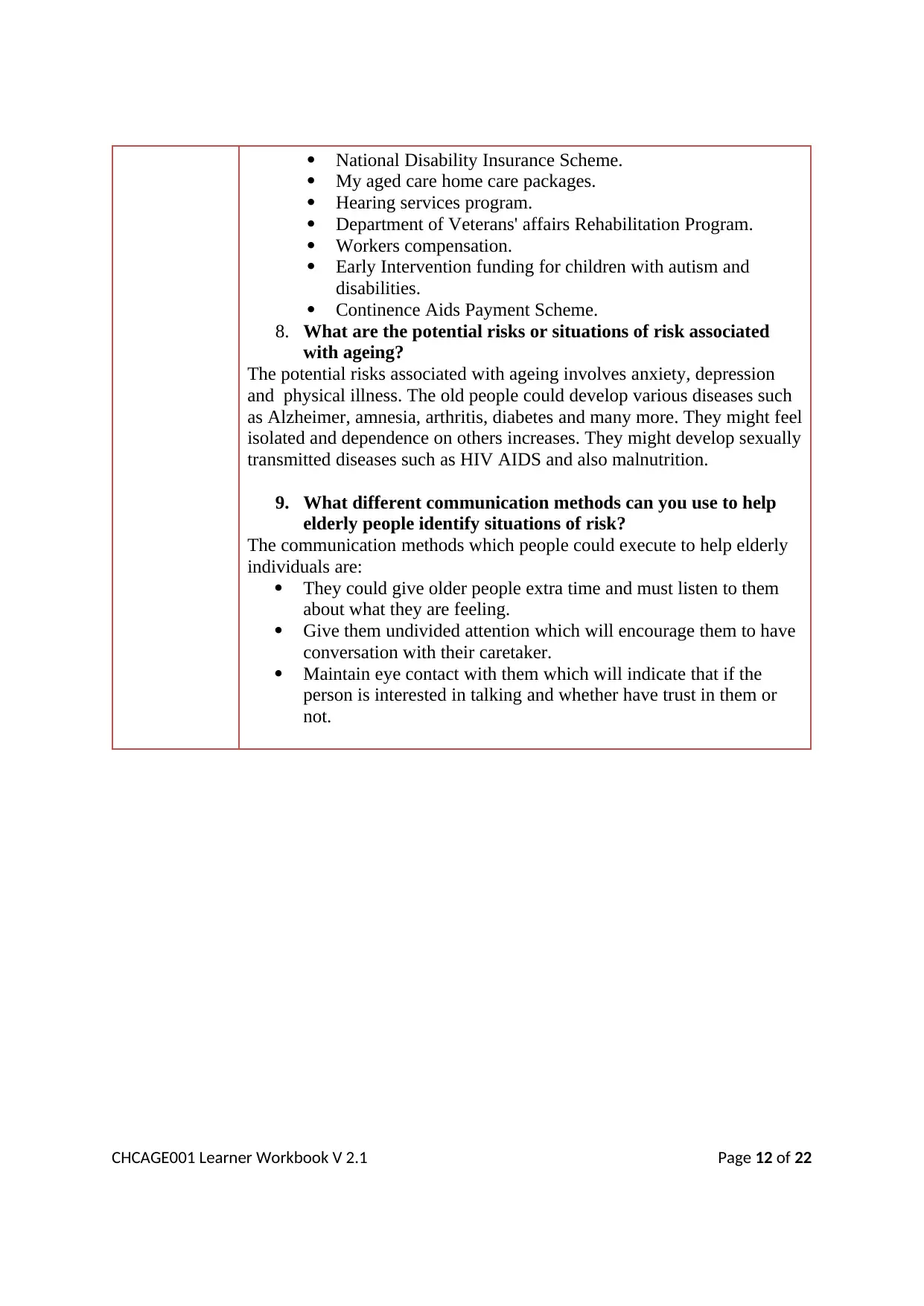
National Disability Insurance Scheme.
My aged care home care packages.
Hearing services program.
Department of Veterans' affairs Rehabilitation Program.
Workers compensation.
Early Intervention funding for children with autism and
disabilities.
Continence Aids Payment Scheme.
8. What are the potential risks or situations of risk associated
with ageing?
The potential risks associated with ageing involves anxiety, depression
and physical illness. The old people could develop various diseases such
as Alzheimer, amnesia, arthritis, diabetes and many more. They might feel
isolated and dependence on others increases. They might develop sexually
transmitted diseases such as HIV AIDS and also malnutrition.
9. What different communication methods can you use to help
elderly people identify situations of risk?
The communication methods which people could execute to help elderly
individuals are:
They could give older people extra time and must listen to them
about what they are feeling.
Give them undivided attention which will encourage them to have
conversation with their caretaker.
Maintain eye contact with them which will indicate that if the
person is interested in talking and whether have trust in them or
not.
CHCAGE001 Learner Workbook V 2.1 Page 12 of 22
My aged care home care packages.
Hearing services program.
Department of Veterans' affairs Rehabilitation Program.
Workers compensation.
Early Intervention funding for children with autism and
disabilities.
Continence Aids Payment Scheme.
8. What are the potential risks or situations of risk associated
with ageing?
The potential risks associated with ageing involves anxiety, depression
and physical illness. The old people could develop various diseases such
as Alzheimer, amnesia, arthritis, diabetes and many more. They might feel
isolated and dependence on others increases. They might develop sexually
transmitted diseases such as HIV AIDS and also malnutrition.
9. What different communication methods can you use to help
elderly people identify situations of risk?
The communication methods which people could execute to help elderly
individuals are:
They could give older people extra time and must listen to them
about what they are feeling.
Give them undivided attention which will encourage them to have
conversation with their caretaker.
Maintain eye contact with them which will indicate that if the
person is interested in talking and whether have trust in them or
not.
CHCAGE001 Learner Workbook V 2.1 Page 12 of 22

Knowledge Assessment :
The summative assessments are the major activities designed to assess the learner’s skills,
knowledge and performance, as required to show competency in this unit. These activities
should be completed after finishing the Learner Guide. These should be completed as stated
under the trainer/assessor instructions.
(MUST BE COMPLETED)
Objective Knowledge Evidence:
structure and profile of the aged care sector:
residential aged care sector
home and community support sector
current best practice service delivery models
relevant agencies and referral networks for support services
key issues facing older people, including:
stereotypical attitudes and myths
the impact of social devaluation on an individual’s quality of
life
implications for work in the sector, including:
concepts of positive, active and healthy ageing
rights-based approaches
person-centred practice
consumer directed care
palliative approach
empowerment and disempowerment
the ageing process and related physiological and psychological
changes, including sexuality and gender issues
strategies that the older person may adopt to promote healthy
lifestyle practices
legal and ethical considerations for working with older people,
including:
codes of practice
discrimination
dignity of risk
duty of care
human rights
privacy, confidentiality and disclosure
work role boundaries – responsibilities and limitations
CHCAGE001 Learner Workbook V 2.1 Page 13 of 22
The summative assessments are the major activities designed to assess the learner’s skills,
knowledge and performance, as required to show competency in this unit. These activities
should be completed after finishing the Learner Guide. These should be completed as stated
under the trainer/assessor instructions.
(MUST BE COMPLETED)
Objective Knowledge Evidence:
structure and profile of the aged care sector:
residential aged care sector
home and community support sector
current best practice service delivery models
relevant agencies and referral networks for support services
key issues facing older people, including:
stereotypical attitudes and myths
the impact of social devaluation on an individual’s quality of
life
implications for work in the sector, including:
concepts of positive, active and healthy ageing
rights-based approaches
person-centred practice
consumer directed care
palliative approach
empowerment and disempowerment
the ageing process and related physiological and psychological
changes, including sexuality and gender issues
strategies that the older person may adopt to promote healthy
lifestyle practices
legal and ethical considerations for working with older people,
including:
codes of practice
discrimination
dignity of risk
duty of care
human rights
privacy, confidentiality and disclosure
work role boundaries – responsibilities and limitations
CHCAGE001 Learner Workbook V 2.1 Page 13 of 22
Paraphrase This Document
Need a fresh take? Get an instant paraphrase of this document with our AI Paraphraser
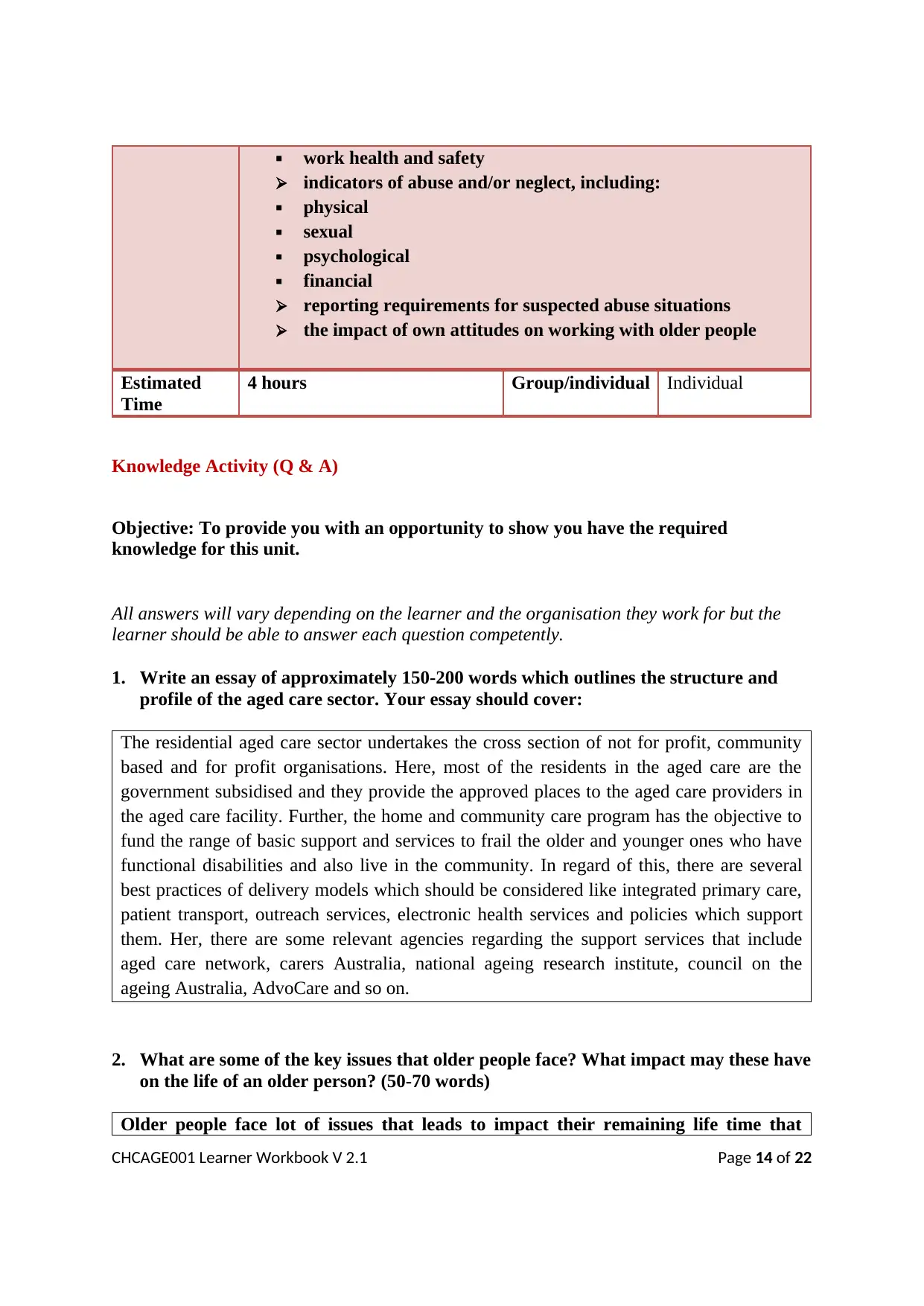
work health and safety
indicators of abuse and/or neglect, including:
physical
sexual
psychological
financial
reporting requirements for suspected abuse situations
the impact of own attitudes on working with older people
Estimated
Time
4 hours Group/individual Individual
Knowledge Activity (Q & A)
Objective: To provide you with an opportunity to show you have the required
knowledge for this unit.
All answers will vary depending on the learner and the organisation they work for but the
learner should be able to answer each question competently.
1. Write an essay of approximately 150-200 words which outlines the structure and
profile of the aged care sector. Your essay should cover:
The residential aged care sector undertakes the cross section of not for profit, community
based and for profit organisations. Here, most of the residents in the aged care are the
government subsidised and they provide the approved places to the aged care providers in
the aged care facility. Further, the home and community care program has the objective to
fund the range of basic support and services to frail the older and younger ones who have
functional disabilities and also live in the community. In regard of this, there are several
best practices of delivery models which should be considered like integrated primary care,
patient transport, outreach services, electronic health services and policies which support
them. Her, there are some relevant agencies regarding the support services that include
aged care network, carers Australia, national ageing research institute, council on the
ageing Australia, AdvoCare and so on.
2. What are some of the key issues that older people face? What impact may these have
on the life of an older person? (50-70 words)
Older people face lot of issues that leads to impact their remaining life time that
CHCAGE001 Learner Workbook V 2.1 Page 14 of 22
indicators of abuse and/or neglect, including:
physical
sexual
psychological
financial
reporting requirements for suspected abuse situations
the impact of own attitudes on working with older people
Estimated
Time
4 hours Group/individual Individual
Knowledge Activity (Q & A)
Objective: To provide you with an opportunity to show you have the required
knowledge for this unit.
All answers will vary depending on the learner and the organisation they work for but the
learner should be able to answer each question competently.
1. Write an essay of approximately 150-200 words which outlines the structure and
profile of the aged care sector. Your essay should cover:
The residential aged care sector undertakes the cross section of not for profit, community
based and for profit organisations. Here, most of the residents in the aged care are the
government subsidised and they provide the approved places to the aged care providers in
the aged care facility. Further, the home and community care program has the objective to
fund the range of basic support and services to frail the older and younger ones who have
functional disabilities and also live in the community. In regard of this, there are several
best practices of delivery models which should be considered like integrated primary care,
patient transport, outreach services, electronic health services and policies which support
them. Her, there are some relevant agencies regarding the support services that include
aged care network, carers Australia, national ageing research institute, council on the
ageing Australia, AdvoCare and so on.
2. What are some of the key issues that older people face? What impact may these have
on the life of an older person? (50-70 words)
Older people face lot of issues that leads to impact their remaining life time that
CHCAGE001 Learner Workbook V 2.1 Page 14 of 22
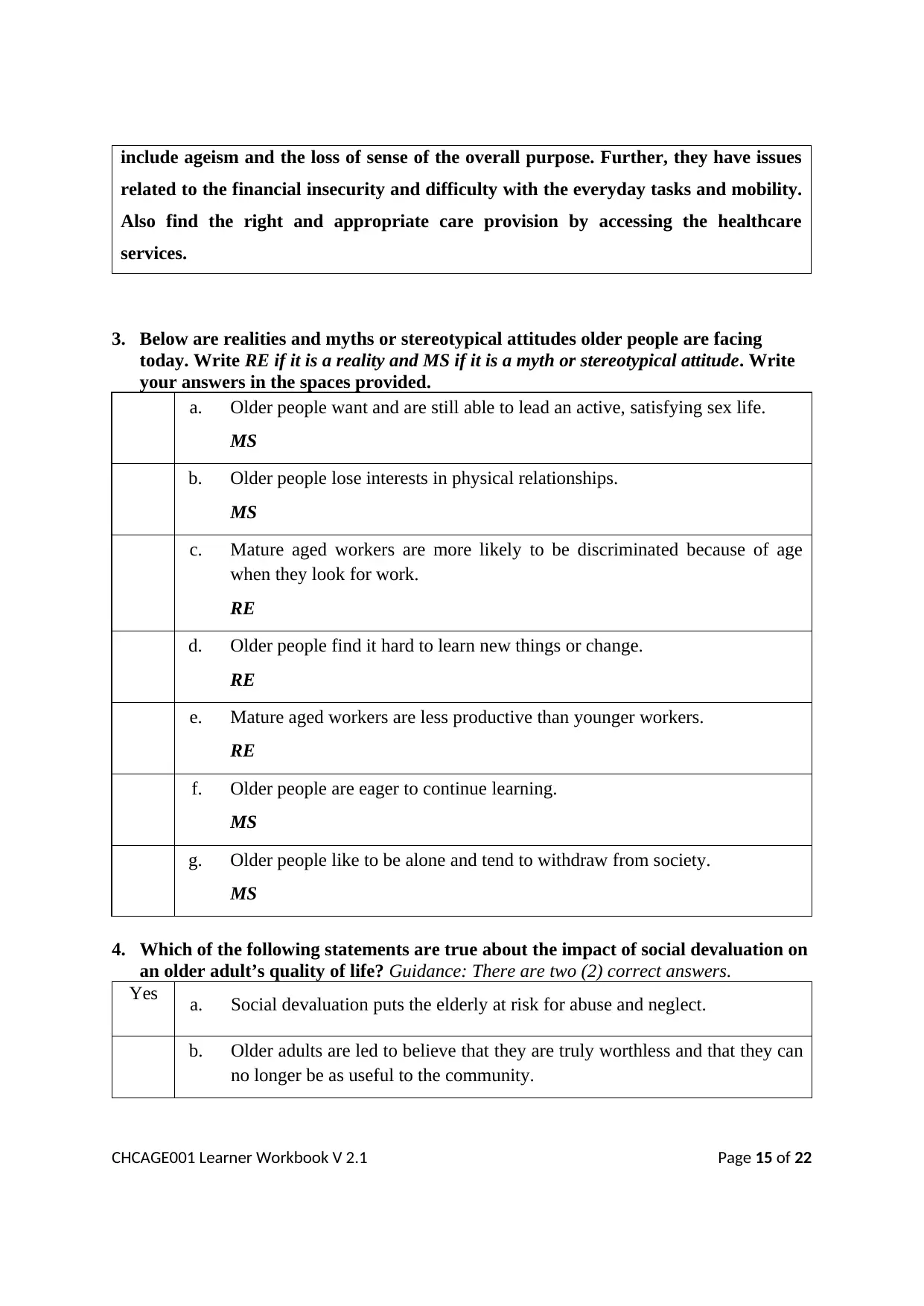
include ageism and the loss of sense of the overall purpose. Further, they have issues
related to the financial insecurity and difficulty with the everyday tasks and mobility.
Also find the right and appropriate care provision by accessing the healthcare
services.
3. Below are realities and myths or stereotypical attitudes older people are facing
today. Write RE if it is a reality and MS if it is a myth or stereotypical attitude. Write
your answers in the spaces provided.
a. Older people want and are still able to lead an active, satisfying sex life.
MS
b. Older people lose interests in physical relationships.
MS
c. Mature aged workers are more likely to be discriminated because of age
when they look for work.
RE
d. Older people find it hard to learn new things or change.
RE
e. Mature aged workers are less productive than younger workers.
RE
f. Older people are eager to continue learning.
MS
g. Older people like to be alone and tend to withdraw from society.
MS
4. Which of the following statements are true about the impact of social devaluation on
an older adult’s quality of life? Guidance: There are two (2) correct answers.
Yes a. Social devaluation puts the elderly at risk for abuse and neglect.
b. Older adults are led to believe that they are truly worthless and that they can
no longer be as useful to the community.
CHCAGE001 Learner Workbook V 2.1 Page 15 of 22
related to the financial insecurity and difficulty with the everyday tasks and mobility.
Also find the right and appropriate care provision by accessing the healthcare
services.
3. Below are realities and myths or stereotypical attitudes older people are facing
today. Write RE if it is a reality and MS if it is a myth or stereotypical attitude. Write
your answers in the spaces provided.
a. Older people want and are still able to lead an active, satisfying sex life.
MS
b. Older people lose interests in physical relationships.
MS
c. Mature aged workers are more likely to be discriminated because of age
when they look for work.
RE
d. Older people find it hard to learn new things or change.
RE
e. Mature aged workers are less productive than younger workers.
RE
f. Older people are eager to continue learning.
MS
g. Older people like to be alone and tend to withdraw from society.
MS
4. Which of the following statements are true about the impact of social devaluation on
an older adult’s quality of life? Guidance: There are two (2) correct answers.
Yes a. Social devaluation puts the elderly at risk for abuse and neglect.
b. Older adults are led to believe that they are truly worthless and that they can
no longer be as useful to the community.
CHCAGE001 Learner Workbook V 2.1 Page 15 of 22
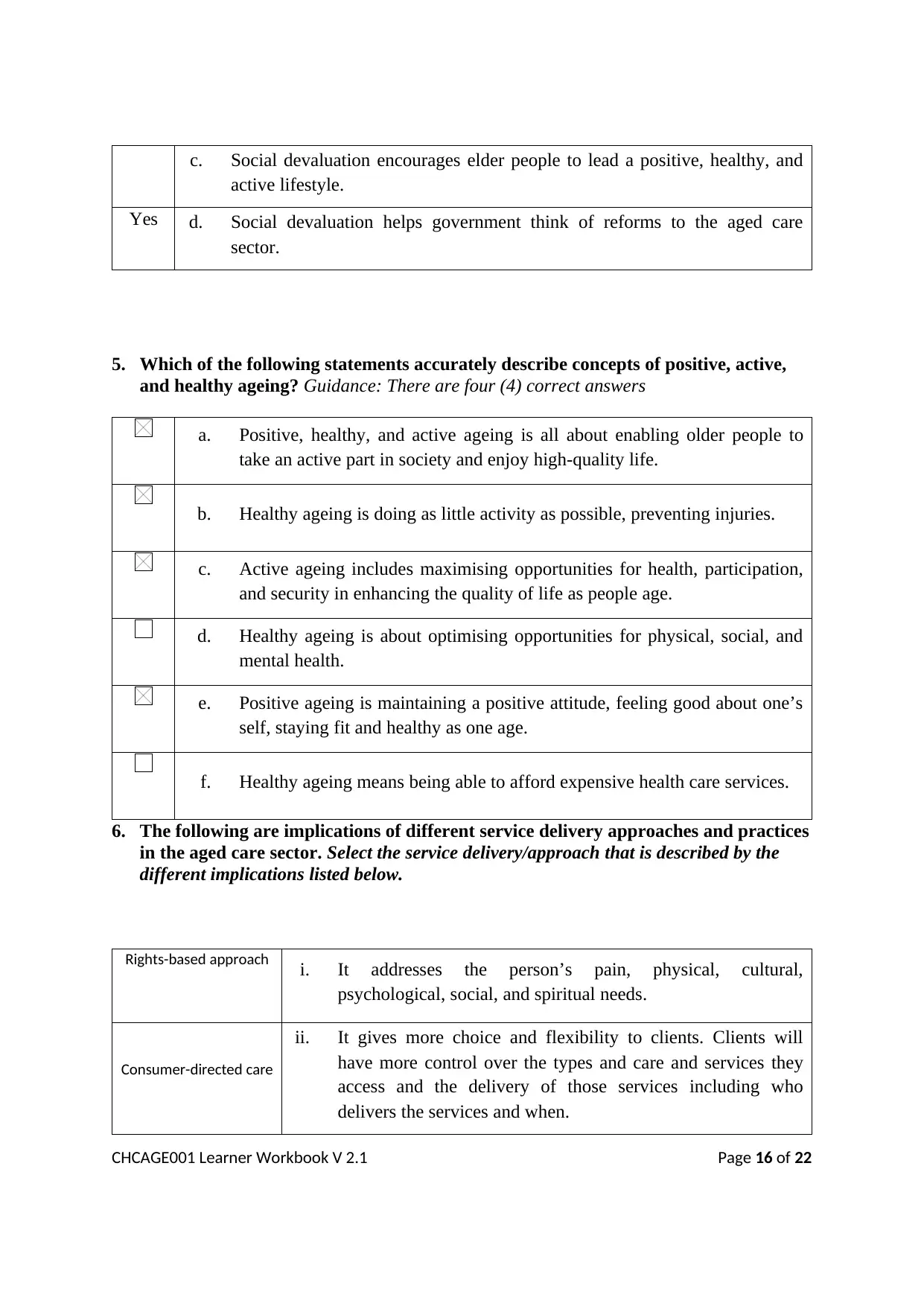
c. Social devaluation encourages elder people to lead a positive, healthy, and
active lifestyle.
Yes d. Social devaluation helps government think of reforms to the aged care
sector.
5. Which of the following statements accurately describe concepts of positive, active,
and healthy ageing? Guidance: There are four (4) correct answers
a. Positive, healthy, and active ageing is all about enabling older people to
take an active part in society and enjoy high-quality life.
b. Healthy ageing is doing as little activity as possible, preventing injuries.
c. Active ageing includes maximising opportunities for health, participation,
and security in enhancing the quality of life as people age.
d. Healthy ageing is about optimising opportunities for physical, social, and
mental health.
e. Positive ageing is maintaining a positive attitude, feeling good about one’s
self, staying fit and healthy as one age.
f. Healthy ageing means being able to afford expensive health care services.
6. The following are implications of different service delivery approaches and practices
in the aged care sector. Select the service delivery/approach that is described by the
different implications listed below.
Rights-based approach i. It addresses the person’s pain, physical, cultural,
psychological, social, and spiritual needs.
Consumer-directed care
ii. It gives more choice and flexibility to clients. Clients will
have more control over the types and care and services they
access and the delivery of those services including who
delivers the services and when.
CHCAGE001 Learner Workbook V 2.1 Page 16 of 22
active lifestyle.
Yes d. Social devaluation helps government think of reforms to the aged care
sector.
5. Which of the following statements accurately describe concepts of positive, active,
and healthy ageing? Guidance: There are four (4) correct answers
a. Positive, healthy, and active ageing is all about enabling older people to
take an active part in society and enjoy high-quality life.
b. Healthy ageing is doing as little activity as possible, preventing injuries.
c. Active ageing includes maximising opportunities for health, participation,
and security in enhancing the quality of life as people age.
d. Healthy ageing is about optimising opportunities for physical, social, and
mental health.
e. Positive ageing is maintaining a positive attitude, feeling good about one’s
self, staying fit and healthy as one age.
f. Healthy ageing means being able to afford expensive health care services.
6. The following are implications of different service delivery approaches and practices
in the aged care sector. Select the service delivery/approach that is described by the
different implications listed below.
Rights-based approach i. It addresses the person’s pain, physical, cultural,
psychological, social, and spiritual needs.
Consumer-directed care
ii. It gives more choice and flexibility to clients. Clients will
have more control over the types and care and services they
access and the delivery of those services including who
delivers the services and when.
CHCAGE001 Learner Workbook V 2.1 Page 16 of 22
Secure Best Marks with AI Grader
Need help grading? Try our AI Grader for instant feedback on your assignments.

Person-centred practice
iii. It places the client at the centre of their care and care planning
and meeting their individualised needs. It aims to see the
elderly as an individual rather than someone who is incapable.
It is also about treating them with dignity and respect.
Empowerment iv. It promotes older people’s dignity and self-worth through
developing their autonomy and independence.
Disempowerment
v. Elderly people feel deprived of authority and control over
their own lives when they are given individual support and
assistance to complete even the simplest day-to-day tasks.
Palliative approach
vi. It improves the quality of life of patients and their families
facing the problems associated with life-threatening illness. It
prevents and relieves suffering through early identification,
assessment, and treatment of pain and other problems,
whether they are physical, psychosocial, or spiritual.
7. What are the physiological and psychological changes that arise with ageing?
Include sexuality and gender changes in your answer. (50 words)
According to studies, while sexual activity declines with age for both genders, sexual
activity, sexual interest, and the quality of sexual life appear to be continuously higher in
men than in women. These gender inequalities become more pronounced as people get
older, and they must be addressed.
8. Which strategies might an older person be able to adopt in order to promote a
healthy lifestyle? Outline at least two. (100 words)
Fitness: Water workouts, swimming, dancing, rapid walking, and cycling are all good
ways to keep your heart and lungs in shape.
Lifting and carrying weights, climbing stairs, squatting, and elevating your legs to the side
all contribute to maintaining muscle tone and bone density.
Avoid chronic stress: Chronic stress has been related to physical health issues like
cardiovascular disease, insulin resistance, and a weakened immune system. This could be
because stress accelerates "cellular ageing" and promotes inflammatory indicators in the
body, according to research.
CHCAGE001 Learner Workbook V 2.1 Page 17 of 22
iii. It places the client at the centre of their care and care planning
and meeting their individualised needs. It aims to see the
elderly as an individual rather than someone who is incapable.
It is also about treating them with dignity and respect.
Empowerment iv. It promotes older people’s dignity and self-worth through
developing their autonomy and independence.
Disempowerment
v. Elderly people feel deprived of authority and control over
their own lives when they are given individual support and
assistance to complete even the simplest day-to-day tasks.
Palliative approach
vi. It improves the quality of life of patients and their families
facing the problems associated with life-threatening illness. It
prevents and relieves suffering through early identification,
assessment, and treatment of pain and other problems,
whether they are physical, psychosocial, or spiritual.
7. What are the physiological and psychological changes that arise with ageing?
Include sexuality and gender changes in your answer. (50 words)
According to studies, while sexual activity declines with age for both genders, sexual
activity, sexual interest, and the quality of sexual life appear to be continuously higher in
men than in women. These gender inequalities become more pronounced as people get
older, and they must be addressed.
8. Which strategies might an older person be able to adopt in order to promote a
healthy lifestyle? Outline at least two. (100 words)
Fitness: Water workouts, swimming, dancing, rapid walking, and cycling are all good
ways to keep your heart and lungs in shape.
Lifting and carrying weights, climbing stairs, squatting, and elevating your legs to the side
all contribute to maintaining muscle tone and bone density.
Avoid chronic stress: Chronic stress has been related to physical health issues like
cardiovascular disease, insulin resistance, and a weakened immune system. This could be
because stress accelerates "cellular ageing" and promotes inflammatory indicators in the
body, according to research.
CHCAGE001 Learner Workbook V 2.1 Page 17 of 22
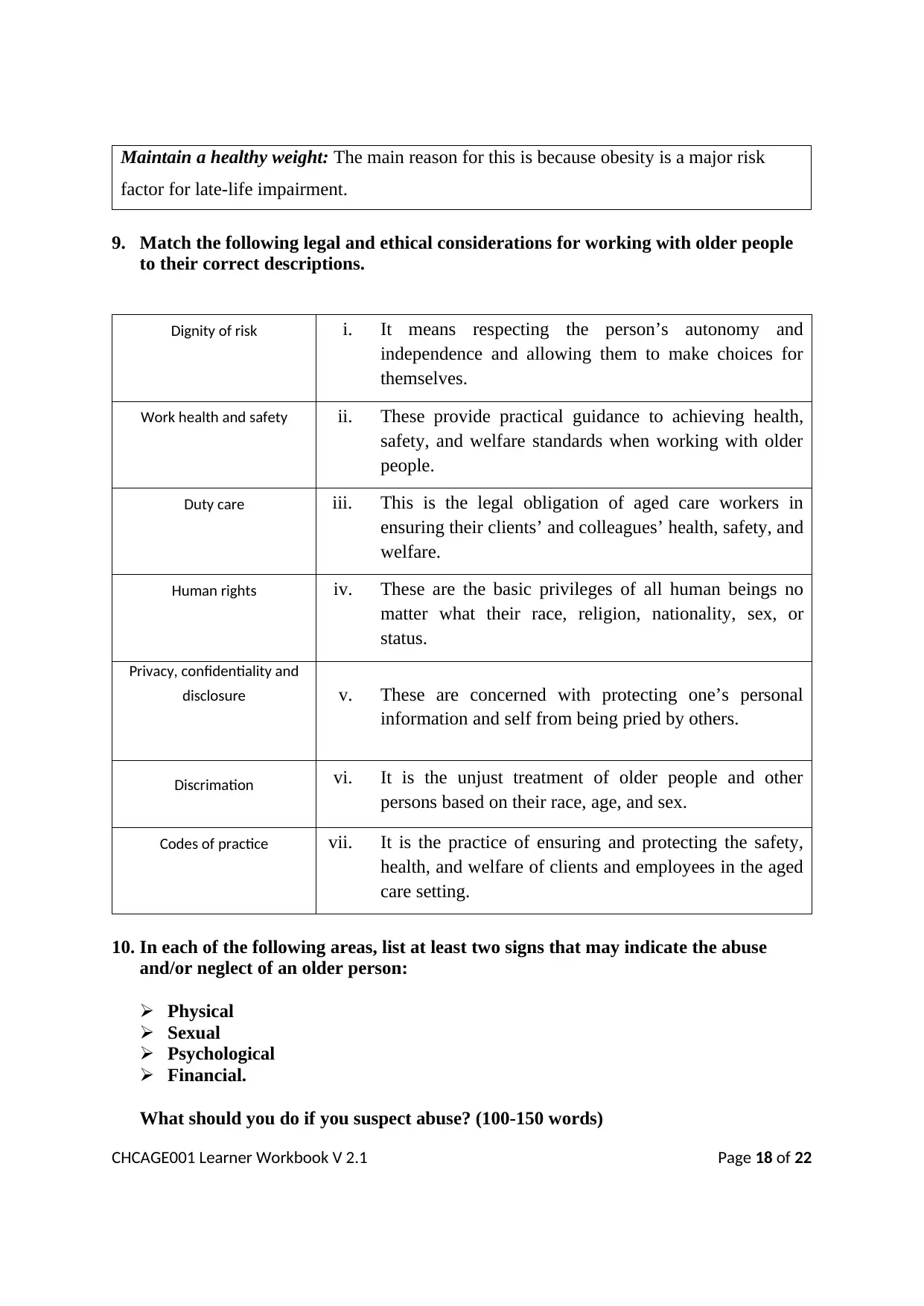
Maintain a healthy weight: The main reason for this is because obesity is a major risk
factor for late-life impairment.
9. Match the following legal and ethical considerations for working with older people
to their correct descriptions.
Dignity of risk i. It means respecting the person’s autonomy and
independence and allowing them to make choices for
themselves.
Work health and safety ii. These provide practical guidance to achieving health,
safety, and welfare standards when working with older
people.
Duty care iii. This is the legal obligation of aged care workers in
ensuring their clients’ and colleagues’ health, safety, and
welfare.
Human rights iv. These are the basic privileges of all human beings no
matter what their race, religion, nationality, sex, or
status.
Privacy, confidentiality and
disclosure v. These are concerned with protecting one’s personal
information and self from being pried by others.
Discrimation vi. It is the unjust treatment of older people and other
persons based on their race, age, and sex.
Codes of practice vii. It is the practice of ensuring and protecting the safety,
health, and welfare of clients and employees in the aged
care setting.
10. In each of the following areas, list at least two signs that may indicate the abuse
and/or neglect of an older person:
Physical
Sexual
Psychological
Financial.
What should you do if you suspect abuse? (100-150 words)
CHCAGE001 Learner Workbook V 2.1 Page 18 of 22
factor for late-life impairment.
9. Match the following legal and ethical considerations for working with older people
to their correct descriptions.
Dignity of risk i. It means respecting the person’s autonomy and
independence and allowing them to make choices for
themselves.
Work health and safety ii. These provide practical guidance to achieving health,
safety, and welfare standards when working with older
people.
Duty care iii. This is the legal obligation of aged care workers in
ensuring their clients’ and colleagues’ health, safety, and
welfare.
Human rights iv. These are the basic privileges of all human beings no
matter what their race, religion, nationality, sex, or
status.
Privacy, confidentiality and
disclosure v. These are concerned with protecting one’s personal
information and self from being pried by others.
Discrimation vi. It is the unjust treatment of older people and other
persons based on their race, age, and sex.
Codes of practice vii. It is the practice of ensuring and protecting the safety,
health, and welfare of clients and employees in the aged
care setting.
10. In each of the following areas, list at least two signs that may indicate the abuse
and/or neglect of an older person:
Physical
Sexual
Psychological
Financial.
What should you do if you suspect abuse? (100-150 words)
CHCAGE001 Learner Workbook V 2.1 Page 18 of 22
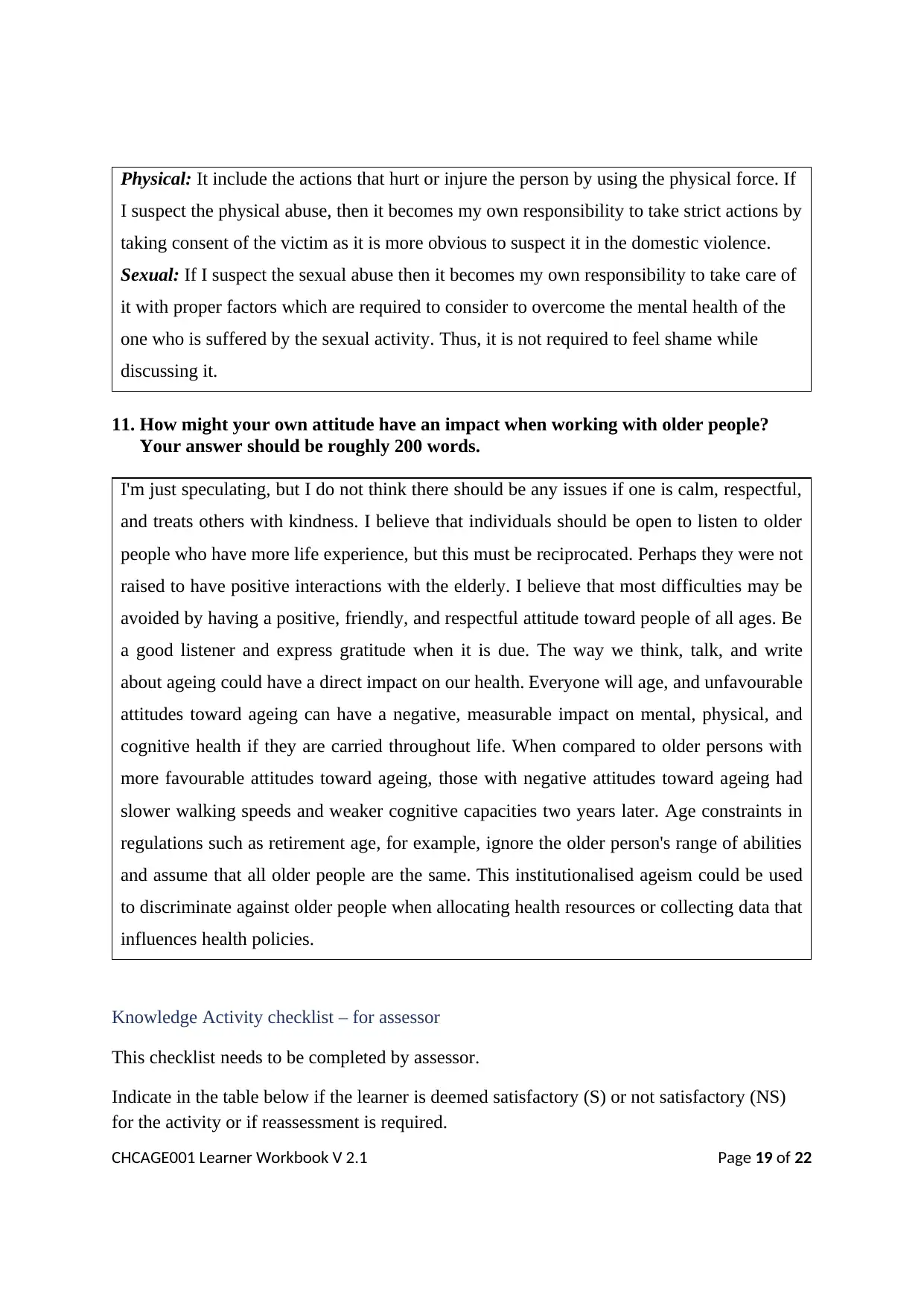
Physical: It include the actions that hurt or injure the person by using the physical force. If
I suspect the physical abuse, then it becomes my own responsibility to take strict actions by
taking consent of the victim as it is more obvious to suspect it in the domestic violence.
Sexual: If I suspect the sexual abuse then it becomes my own responsibility to take care of
it with proper factors which are required to consider to overcome the mental health of the
one who is suffered by the sexual activity. Thus, it is not required to feel shame while
discussing it.
11. How might your own attitude have an impact when working with older people?
Your answer should be roughly 200 words.
I'm just speculating, but I do not think there should be any issues if one is calm, respectful,
and treats others with kindness. I believe that individuals should be open to listen to older
people who have more life experience, but this must be reciprocated. Perhaps they were not
raised to have positive interactions with the elderly. I believe that most difficulties may be
avoided by having a positive, friendly, and respectful attitude toward people of all ages. Be
a good listener and express gratitude when it is due. The way we think, talk, and write
about ageing could have a direct impact on our health. Everyone will age, and unfavourable
attitudes toward ageing can have a negative, measurable impact on mental, physical, and
cognitive health if they are carried throughout life. When compared to older persons with
more favourable attitudes toward ageing, those with negative attitudes toward ageing had
slower walking speeds and weaker cognitive capacities two years later. Age constraints in
regulations such as retirement age, for example, ignore the older person's range of abilities
and assume that all older people are the same. This institutionalised ageism could be used
to discriminate against older people when allocating health resources or collecting data that
influences health policies.
Knowledge Activity checklist – for assessor
This checklist needs to be completed by assessor.
Indicate in the table below if the learner is deemed satisfactory (S) or not satisfactory (NS)
for the activity or if reassessment is required.
CHCAGE001 Learner Workbook V 2.1 Page 19 of 22
I suspect the physical abuse, then it becomes my own responsibility to take strict actions by
taking consent of the victim as it is more obvious to suspect it in the domestic violence.
Sexual: If I suspect the sexual abuse then it becomes my own responsibility to take care of
it with proper factors which are required to consider to overcome the mental health of the
one who is suffered by the sexual activity. Thus, it is not required to feel shame while
discussing it.
11. How might your own attitude have an impact when working with older people?
Your answer should be roughly 200 words.
I'm just speculating, but I do not think there should be any issues if one is calm, respectful,
and treats others with kindness. I believe that individuals should be open to listen to older
people who have more life experience, but this must be reciprocated. Perhaps they were not
raised to have positive interactions with the elderly. I believe that most difficulties may be
avoided by having a positive, friendly, and respectful attitude toward people of all ages. Be
a good listener and express gratitude when it is due. The way we think, talk, and write
about ageing could have a direct impact on our health. Everyone will age, and unfavourable
attitudes toward ageing can have a negative, measurable impact on mental, physical, and
cognitive health if they are carried throughout life. When compared to older persons with
more favourable attitudes toward ageing, those with negative attitudes toward ageing had
slower walking speeds and weaker cognitive capacities two years later. Age constraints in
regulations such as retirement age, for example, ignore the older person's range of abilities
and assume that all older people are the same. This institutionalised ageism could be used
to discriminate against older people when allocating health resources or collecting data that
influences health policies.
Knowledge Activity checklist – for assessor
This checklist needs to be completed by assessor.
Indicate in the table below if the learner is deemed satisfactory (S) or not satisfactory (NS)
for the activity or if reassessment is required.
CHCAGE001 Learner Workbook V 2.1 Page 19 of 22
Paraphrase This Document
Need a fresh take? Get an instant paraphrase of this document with our AI Paraphraser
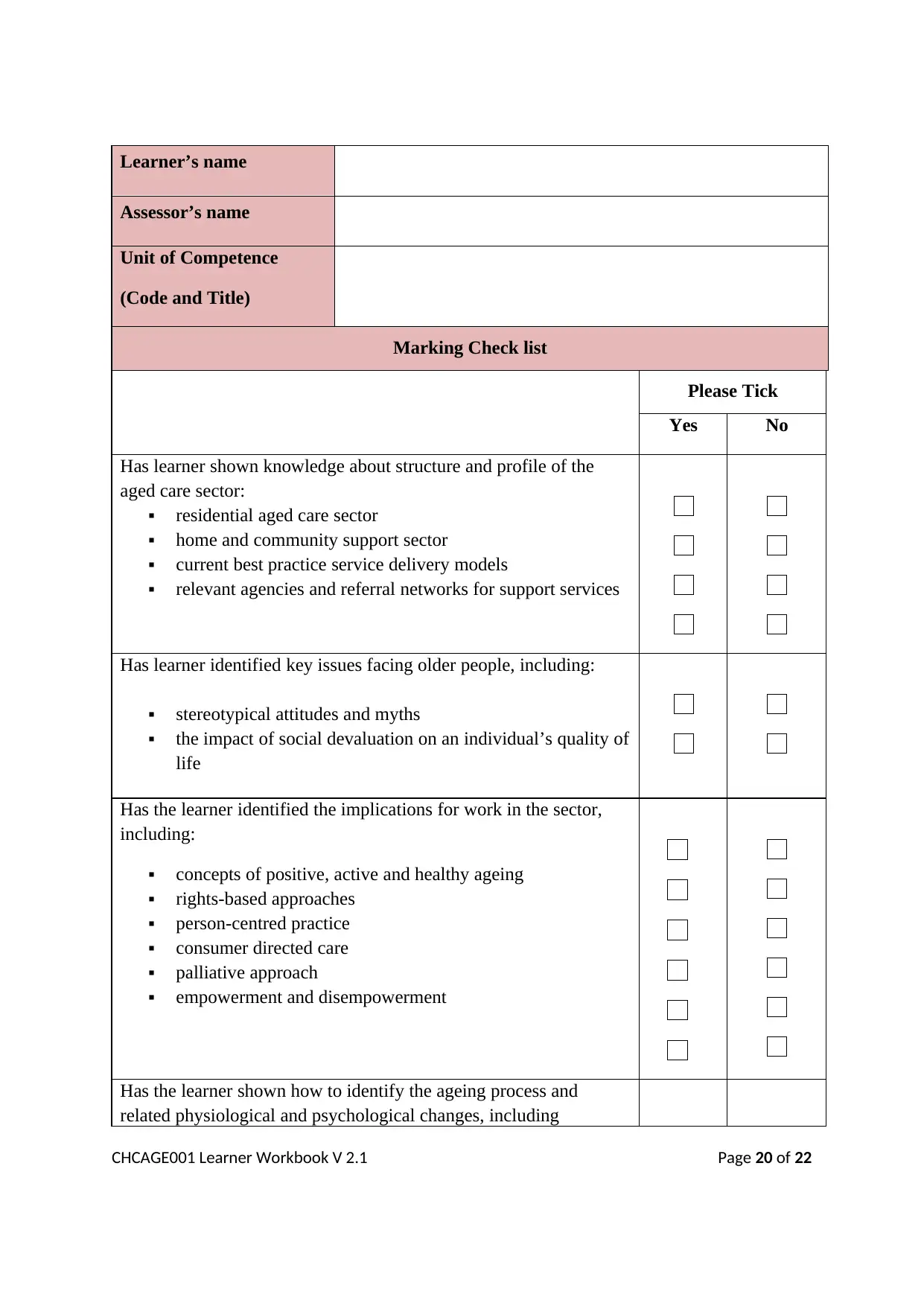
Learner’s name
Assessor’s name
Unit of Competence
(Code and Title)
Marking Check list
Please Tick
Yes No
Has learner shown knowledge about structure and profile of the
aged care sector:
residential aged care sector
home and community support sector
current best practice service delivery models
relevant agencies and referral networks for support services
Has learner identified key issues facing older people, including:
stereotypical attitudes and myths
the impact of social devaluation on an individual’s quality of
life
Has the learner identified the implications for work in the sector,
including:
concepts of positive, active and healthy ageing
rights-based approaches
person-centred practice
consumer directed care
palliative approach
empowerment and disempowerment
Has the learner shown how to identify the ageing process and
related physiological and psychological changes, including
CHCAGE001 Learner Workbook V 2.1 Page 20 of 22
Assessor’s name
Unit of Competence
(Code and Title)
Marking Check list
Please Tick
Yes No
Has learner shown knowledge about structure and profile of the
aged care sector:
residential aged care sector
home and community support sector
current best practice service delivery models
relevant agencies and referral networks for support services
Has learner identified key issues facing older people, including:
stereotypical attitudes and myths
the impact of social devaluation on an individual’s quality of
life
Has the learner identified the implications for work in the sector,
including:
concepts of positive, active and healthy ageing
rights-based approaches
person-centred practice
consumer directed care
palliative approach
empowerment and disempowerment
Has the learner shown how to identify the ageing process and
related physiological and psychological changes, including
CHCAGE001 Learner Workbook V 2.1 Page 20 of 22
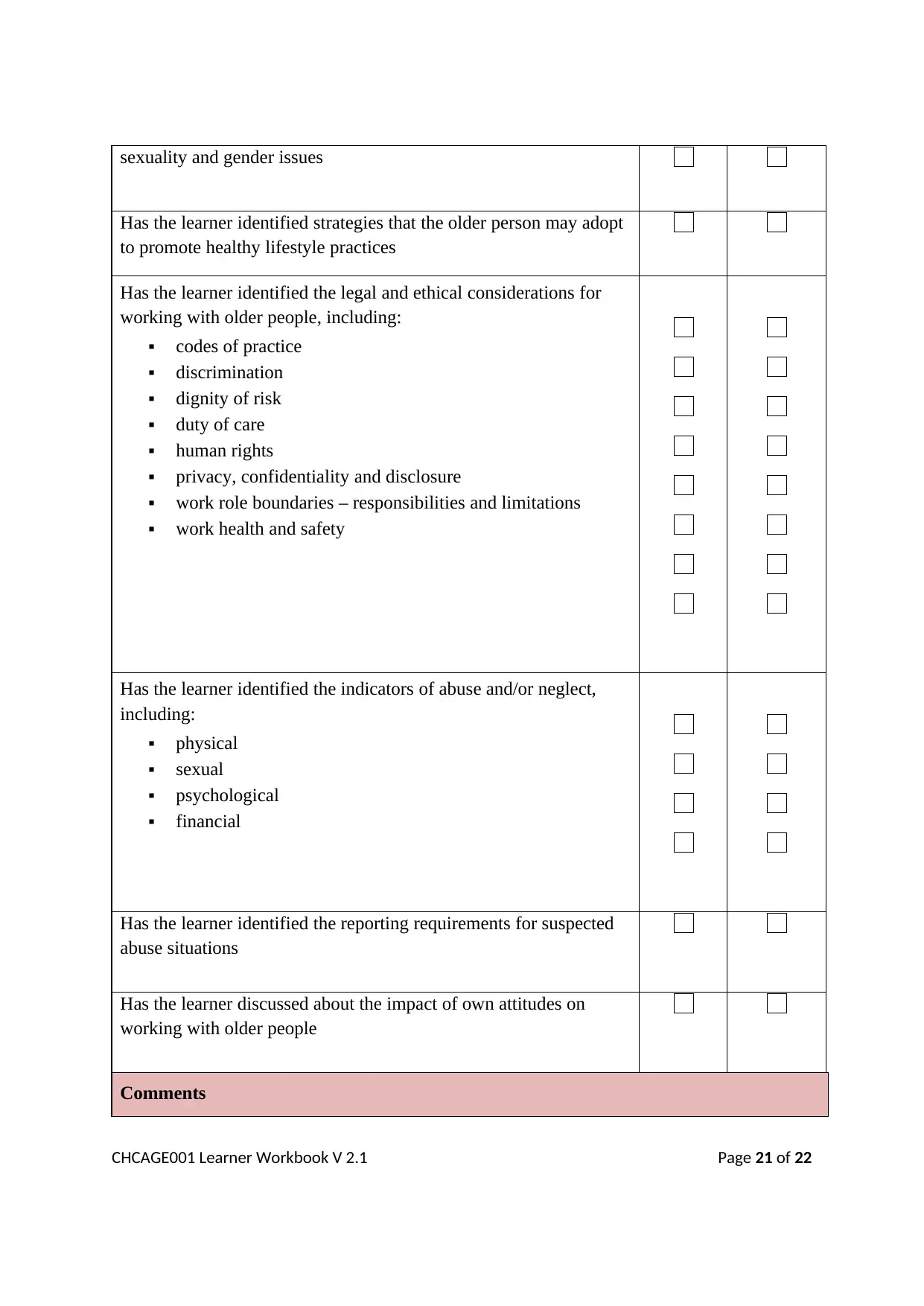
sexuality and gender issues
Has the learner identified strategies that the older person may adopt
to promote healthy lifestyle practices
Has the learner identified the legal and ethical considerations for
working with older people, including:
codes of practice
discrimination
dignity of risk
duty of care
human rights
privacy, confidentiality and disclosure
work role boundaries – responsibilities and limitations
work health and safety
Has the learner identified the indicators of abuse and/or neglect,
including:
physical
sexual
psychological
financial
Has the learner identified the reporting requirements for suspected
abuse situations
Has the learner discussed about the impact of own attitudes on
working with older people
Comments
CHCAGE001 Learner Workbook V 2.1 Page 21 of 22
Has the learner identified strategies that the older person may adopt
to promote healthy lifestyle practices
Has the learner identified the legal and ethical considerations for
working with older people, including:
codes of practice
discrimination
dignity of risk
duty of care
human rights
privacy, confidentiality and disclosure
work role boundaries – responsibilities and limitations
work health and safety
Has the learner identified the indicators of abuse and/or neglect,
including:
physical
sexual
psychological
financial
Has the learner identified the reporting requirements for suspected
abuse situations
Has the learner discussed about the impact of own attitudes on
working with older people
Comments
CHCAGE001 Learner Workbook V 2.1 Page 21 of 22
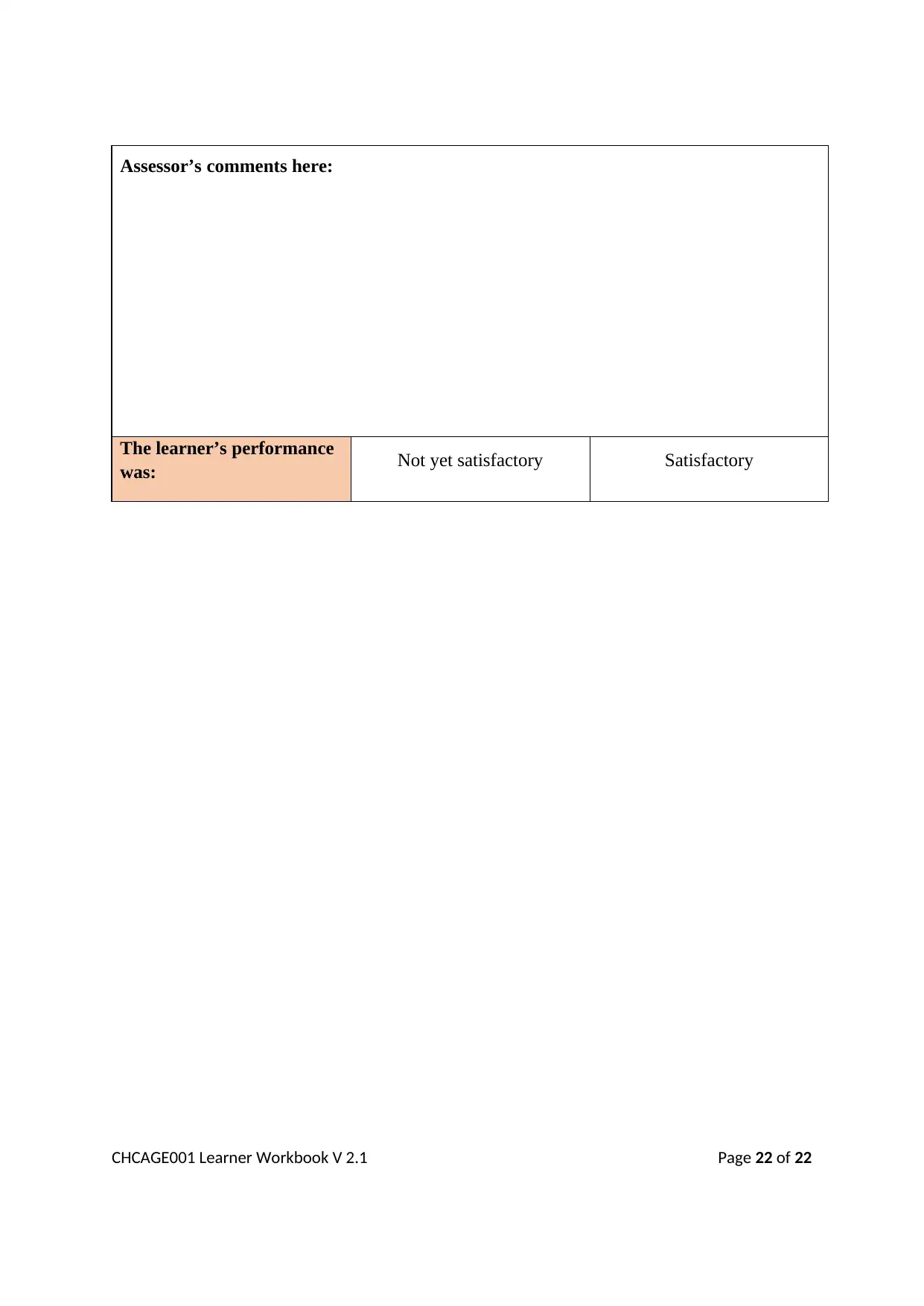
Assessor’s comments here:
The learner’s performance
was: Not yet satisfactory Satisfactory
CHCAGE001 Learner Workbook V 2.1 Page 22 of 22
The learner’s performance
was: Not yet satisfactory Satisfactory
CHCAGE001 Learner Workbook V 2.1 Page 22 of 22
1 out of 22
Related Documents
Your All-in-One AI-Powered Toolkit for Academic Success.
+13062052269
info@desklib.com
Available 24*7 on WhatsApp / Email
![[object Object]](/_next/static/media/star-bottom.7253800d.svg)
Unlock your academic potential
© 2024 | Zucol Services PVT LTD | All rights reserved.





